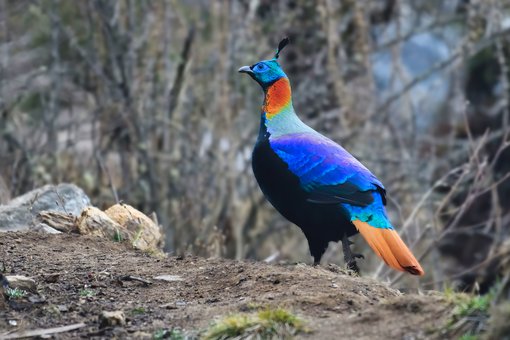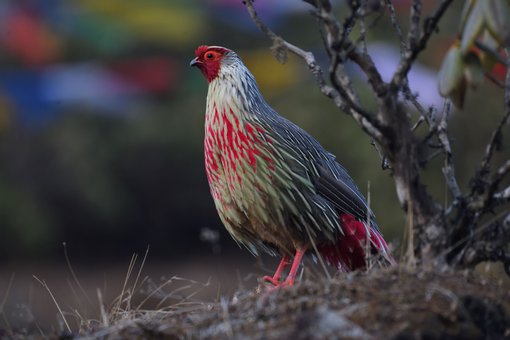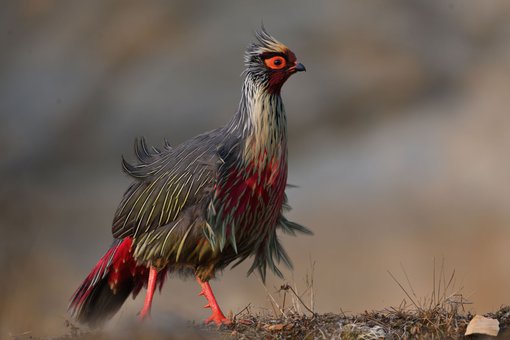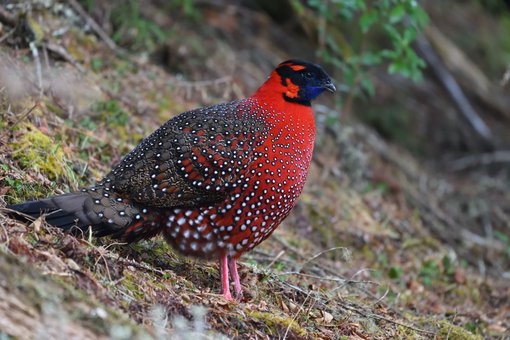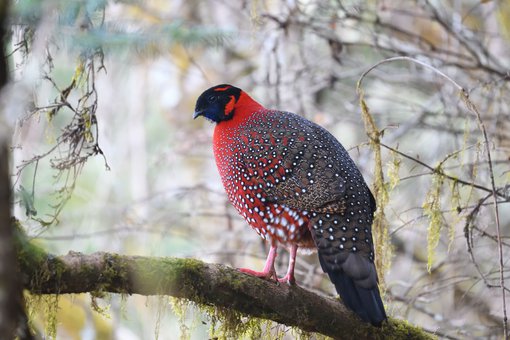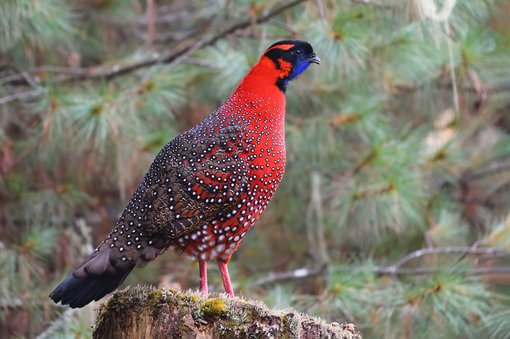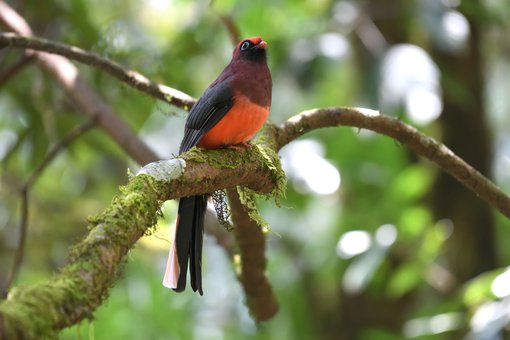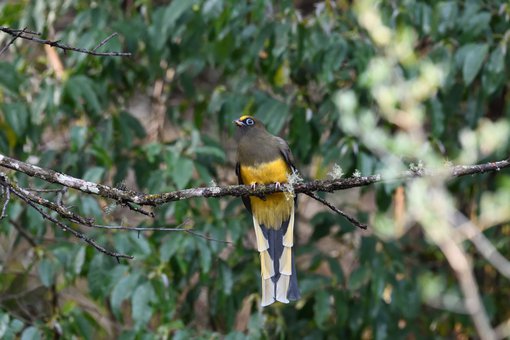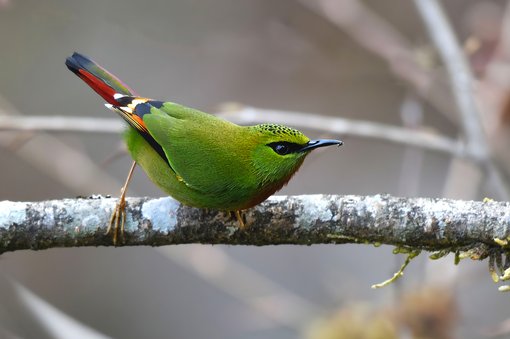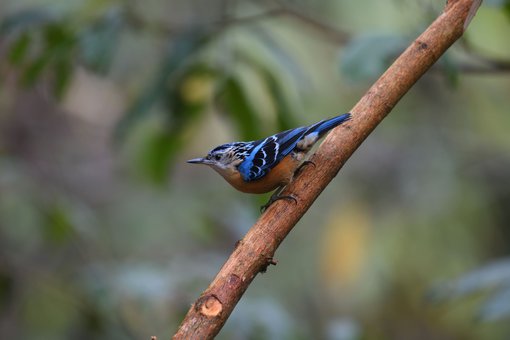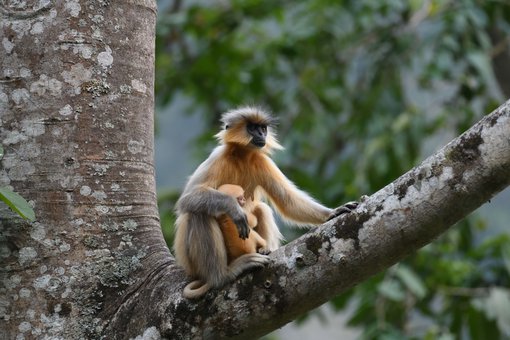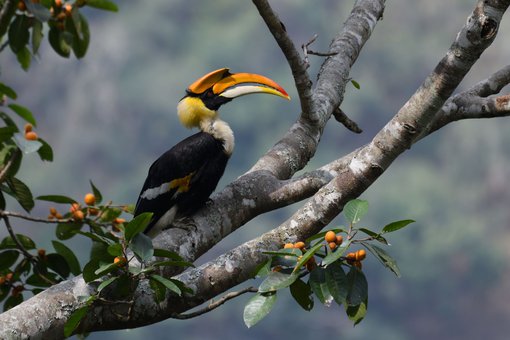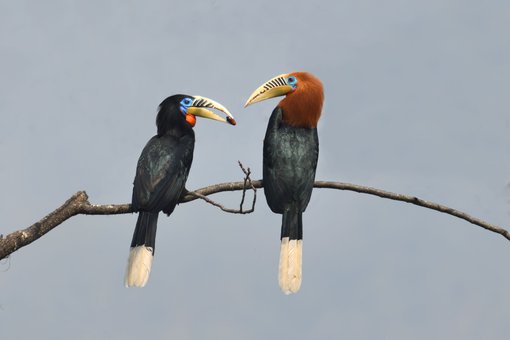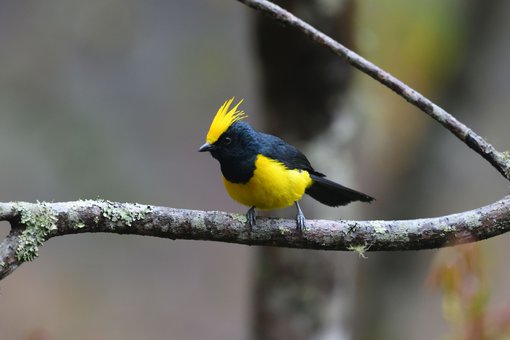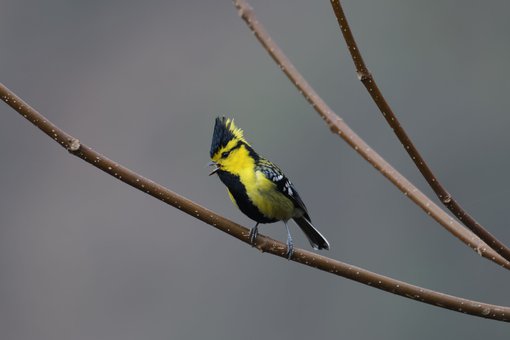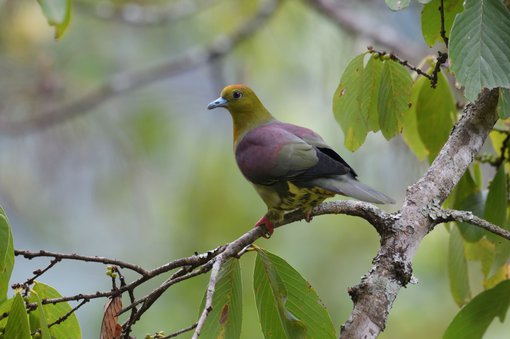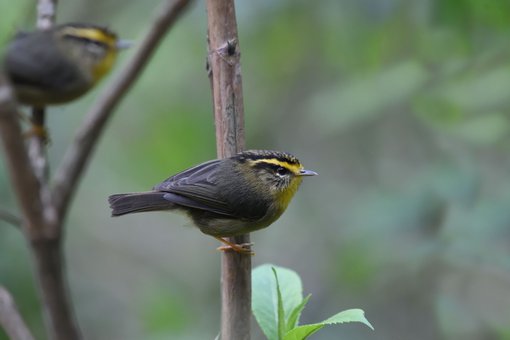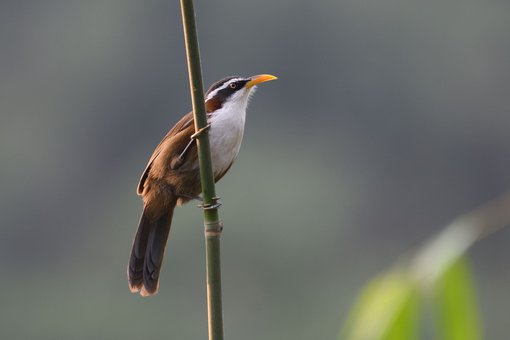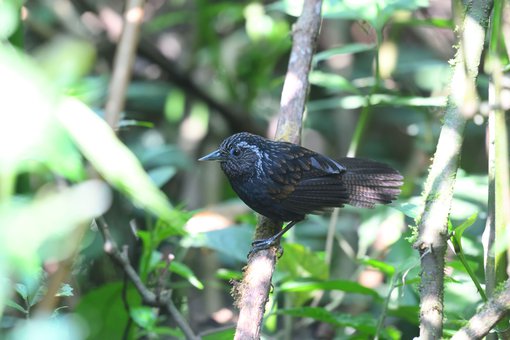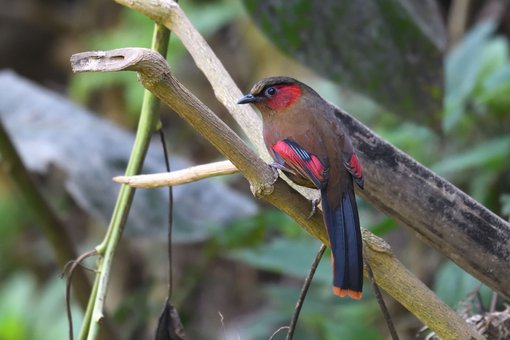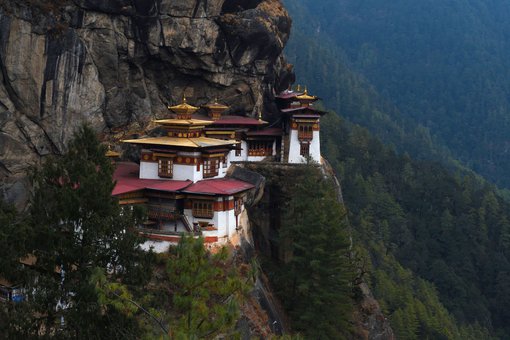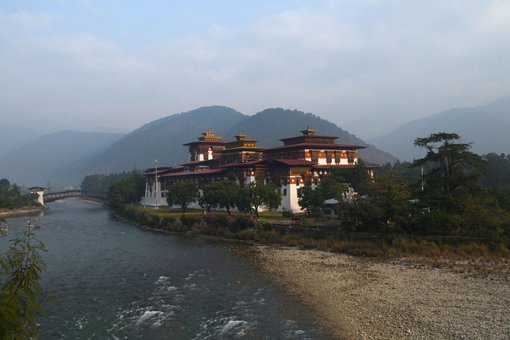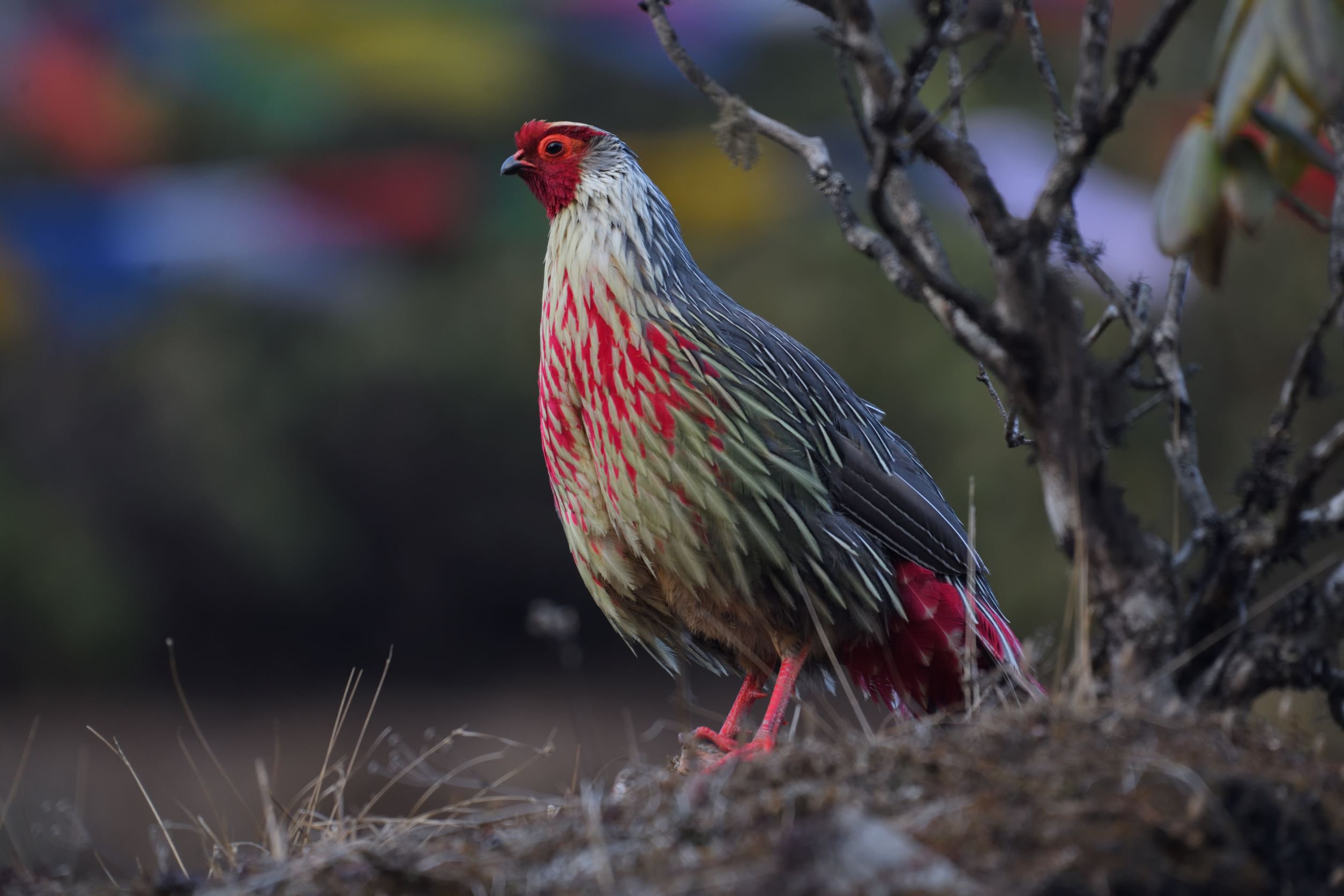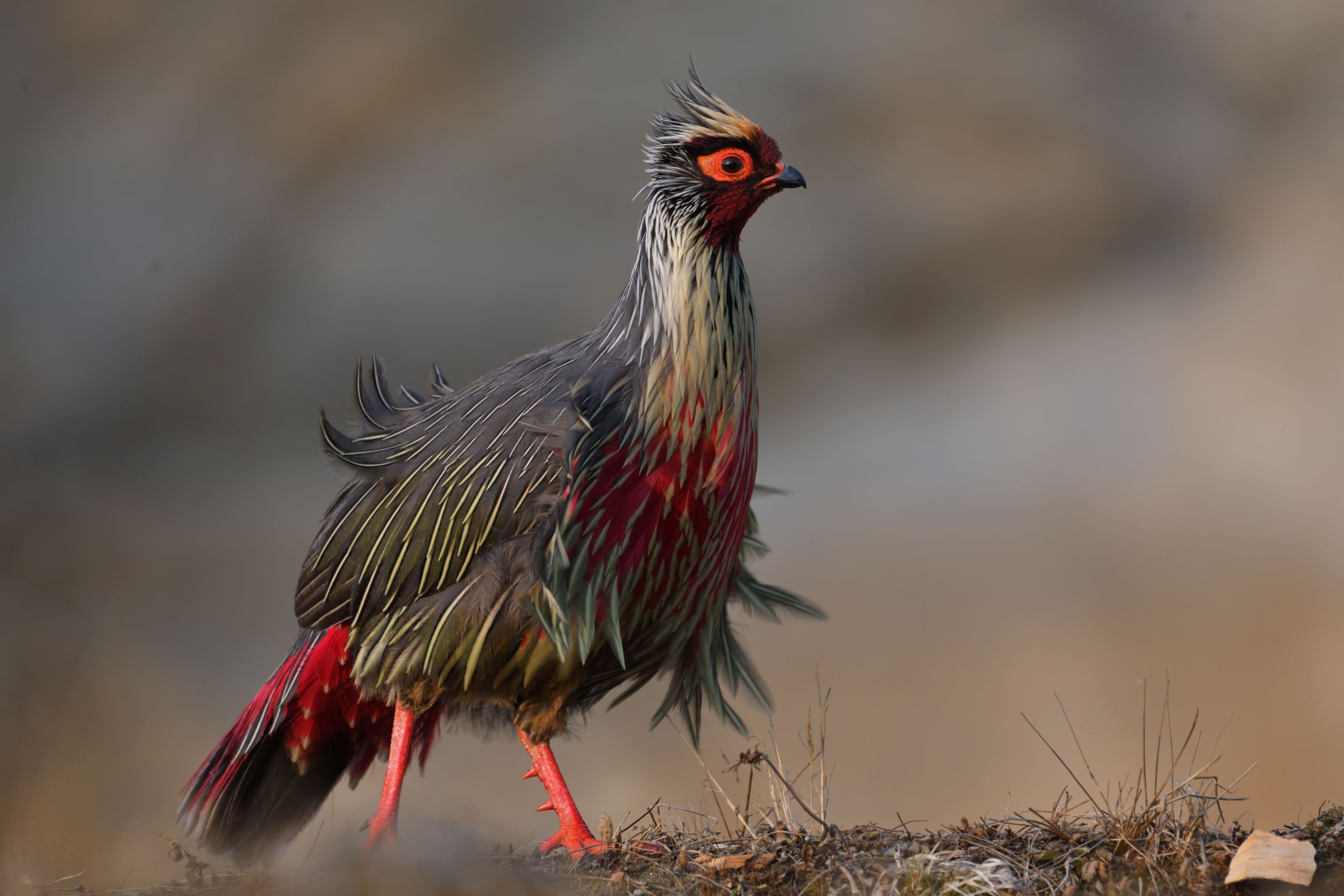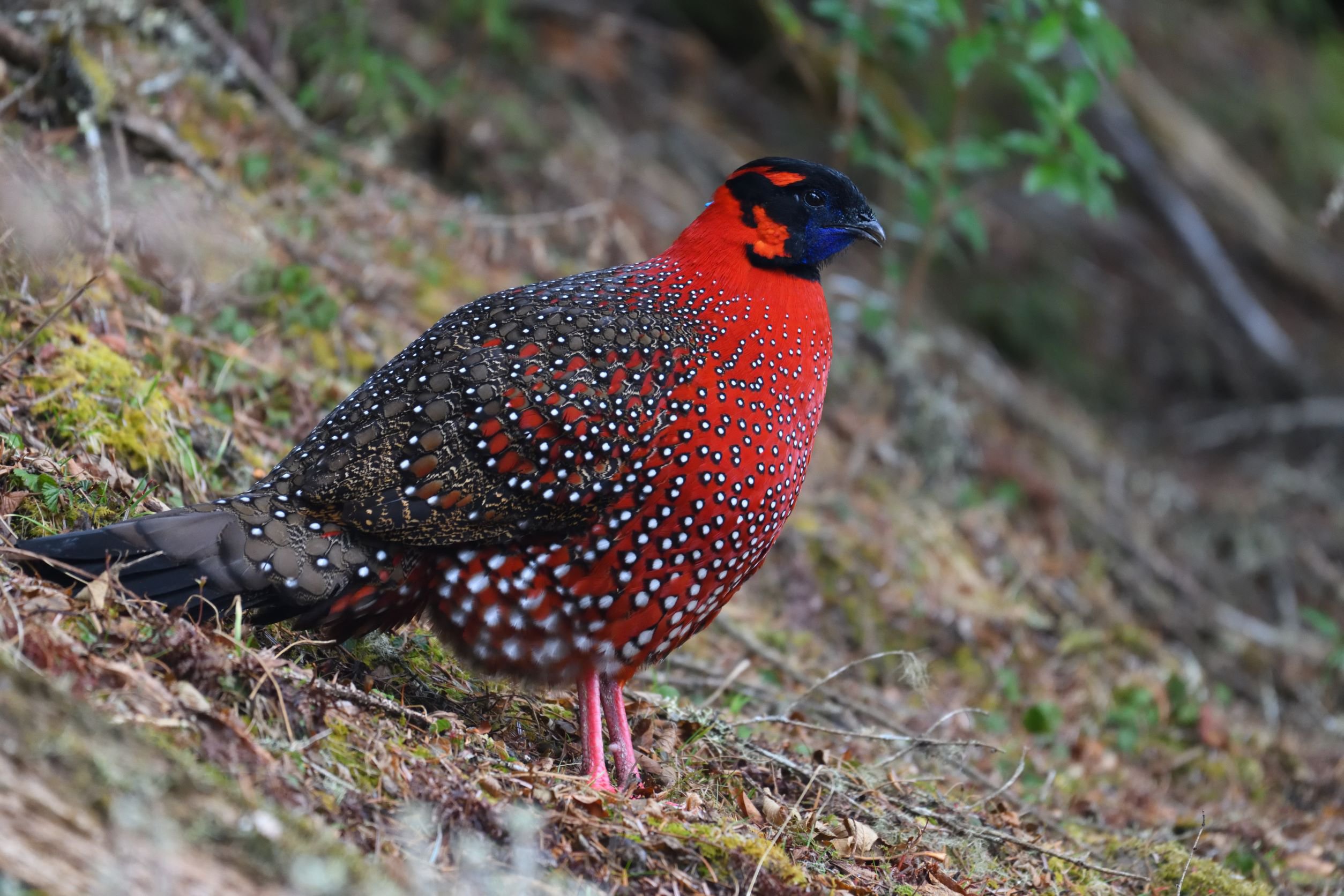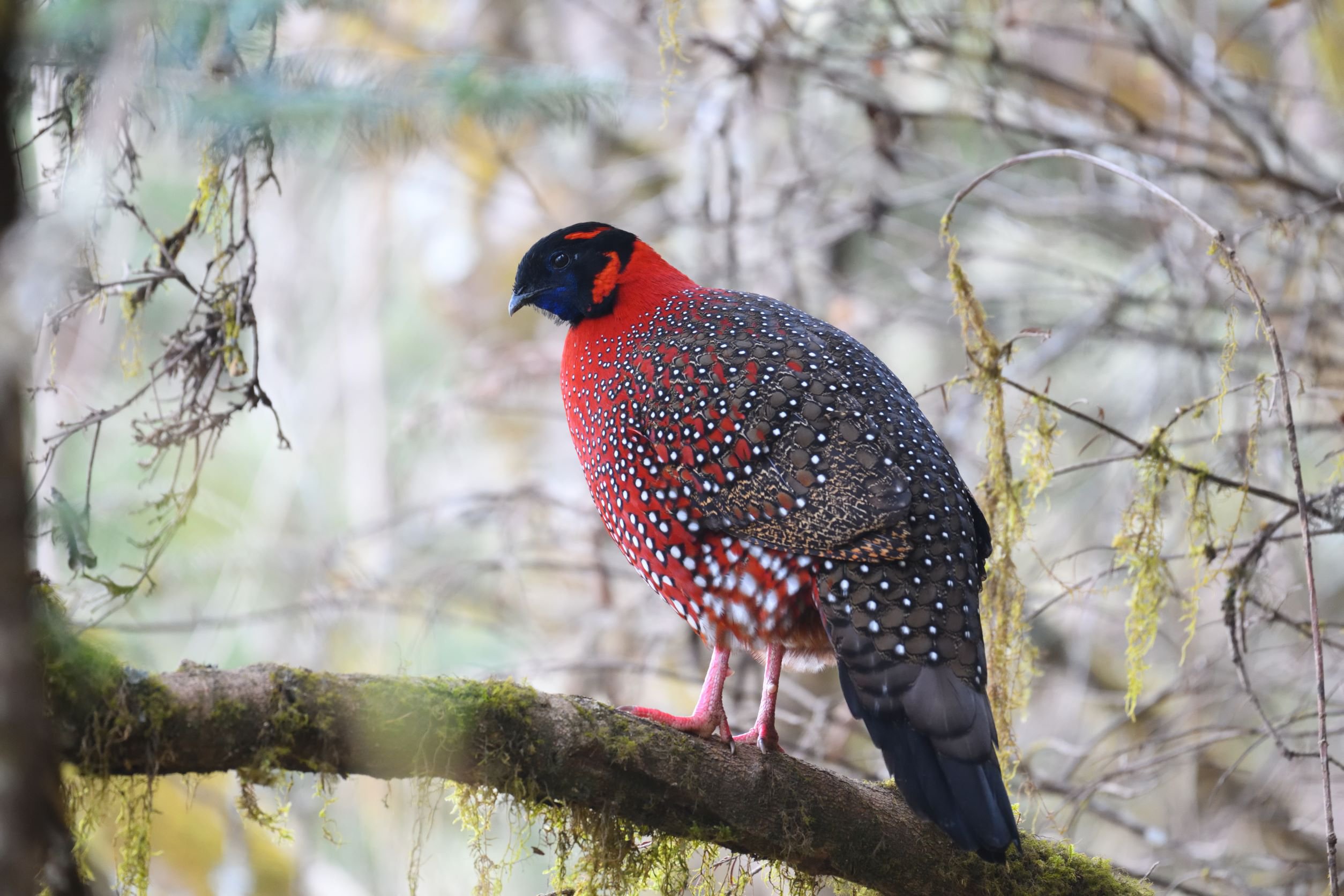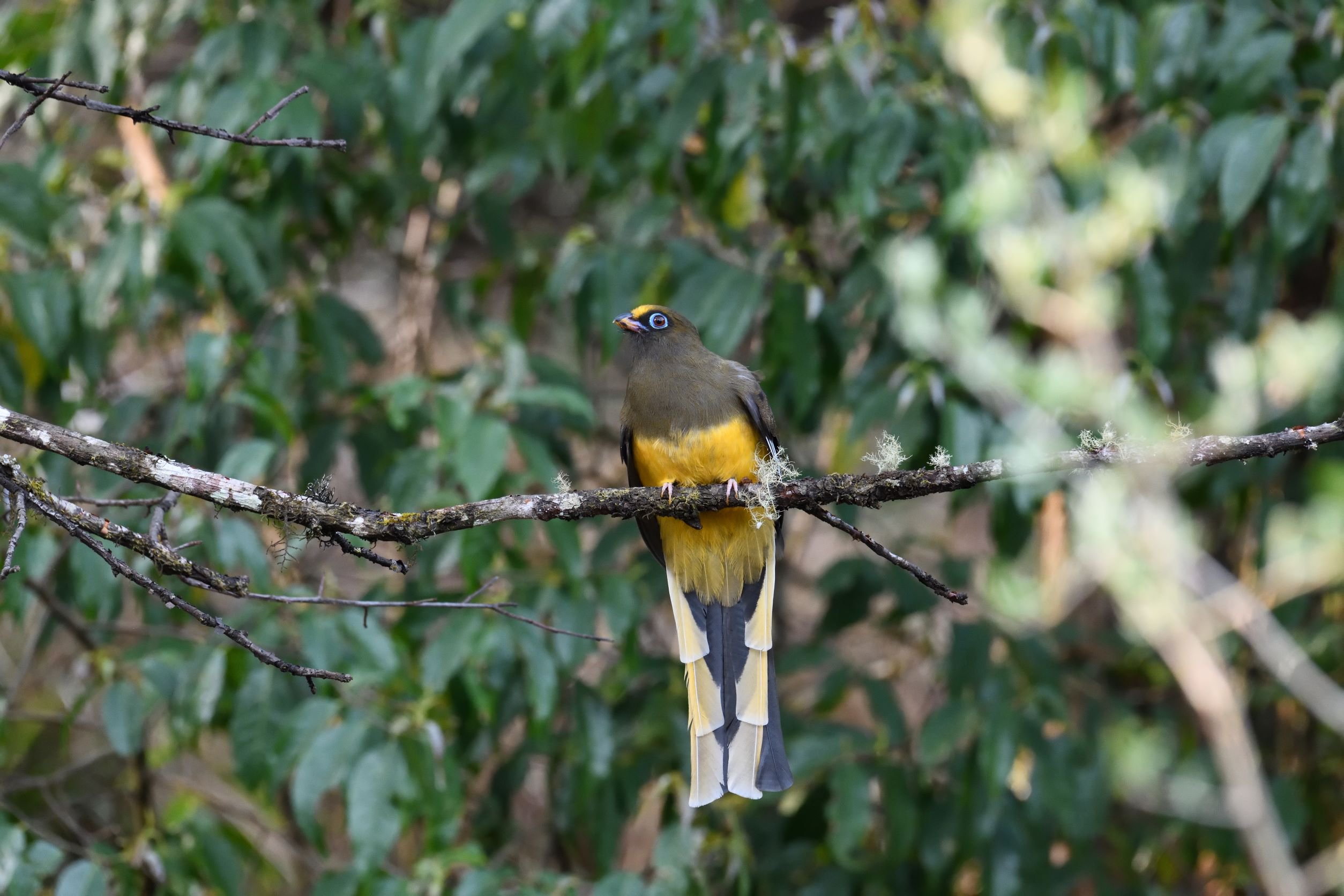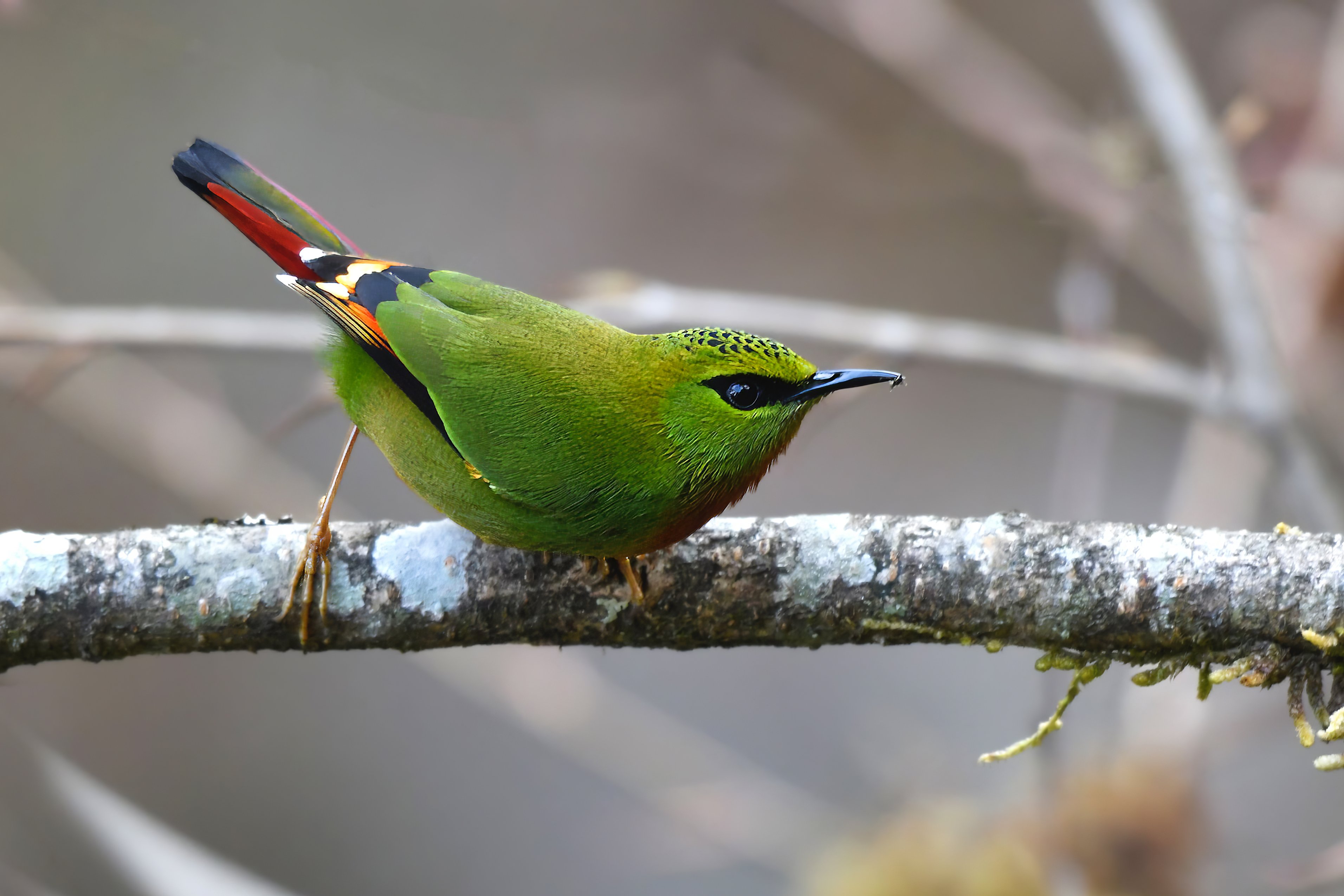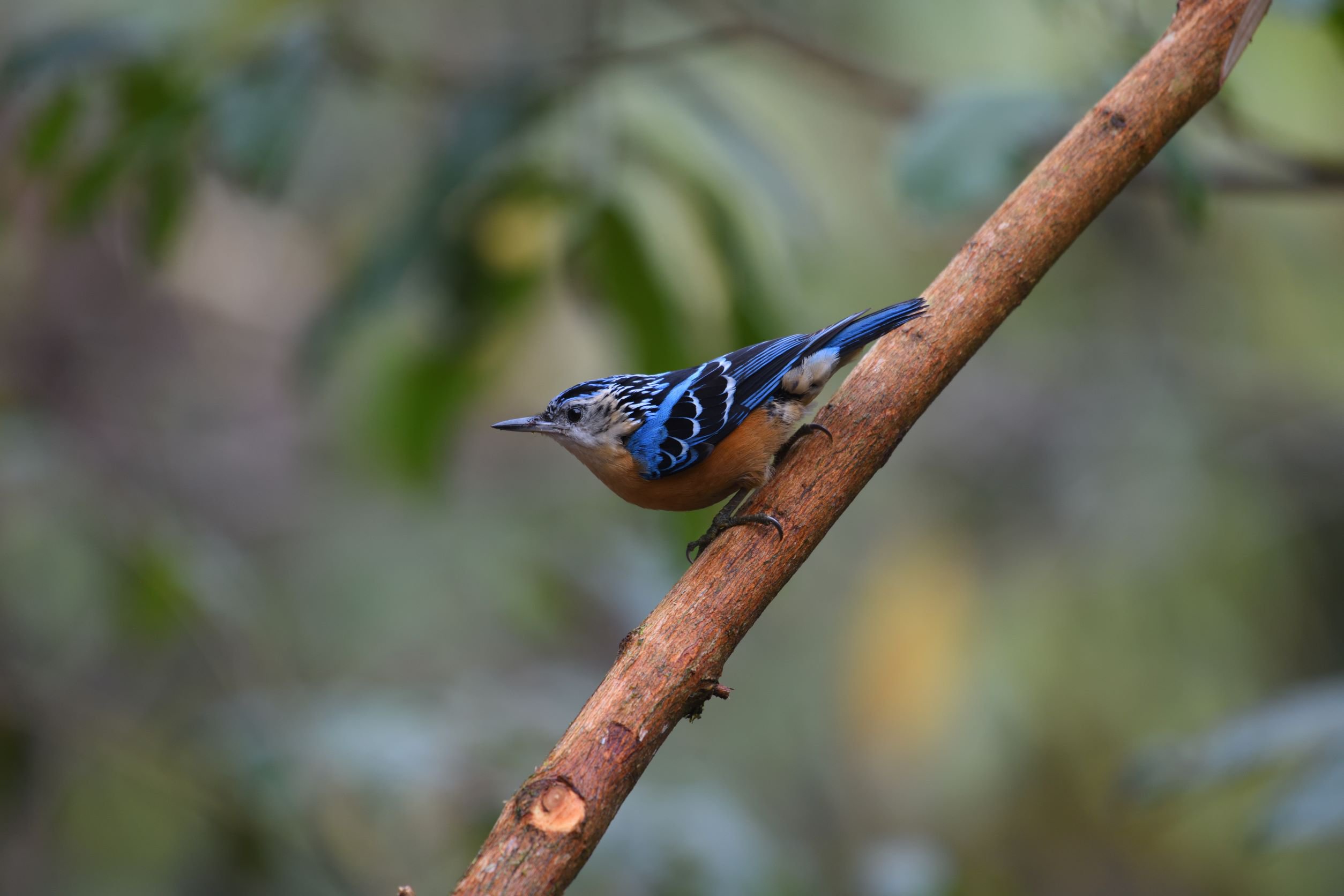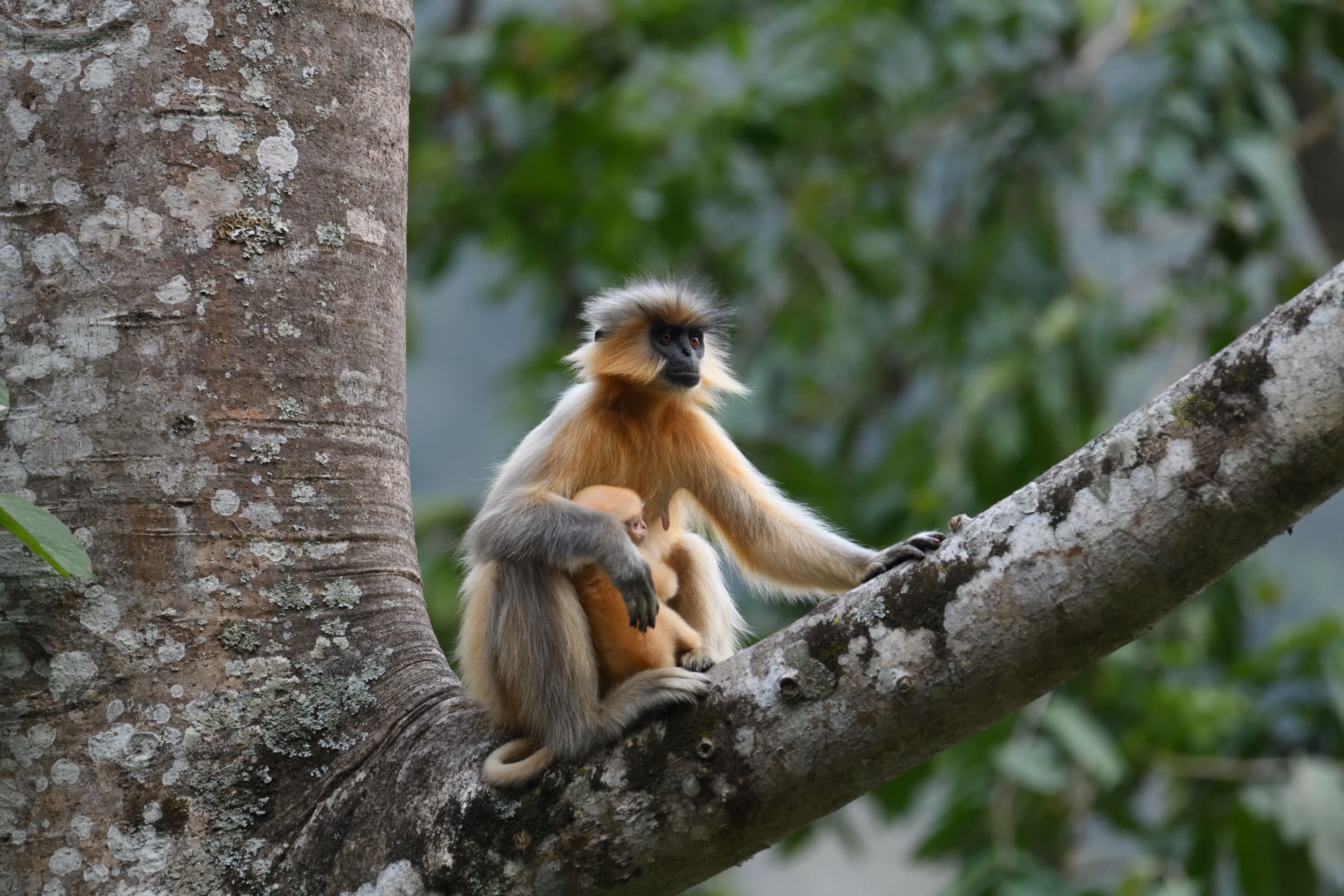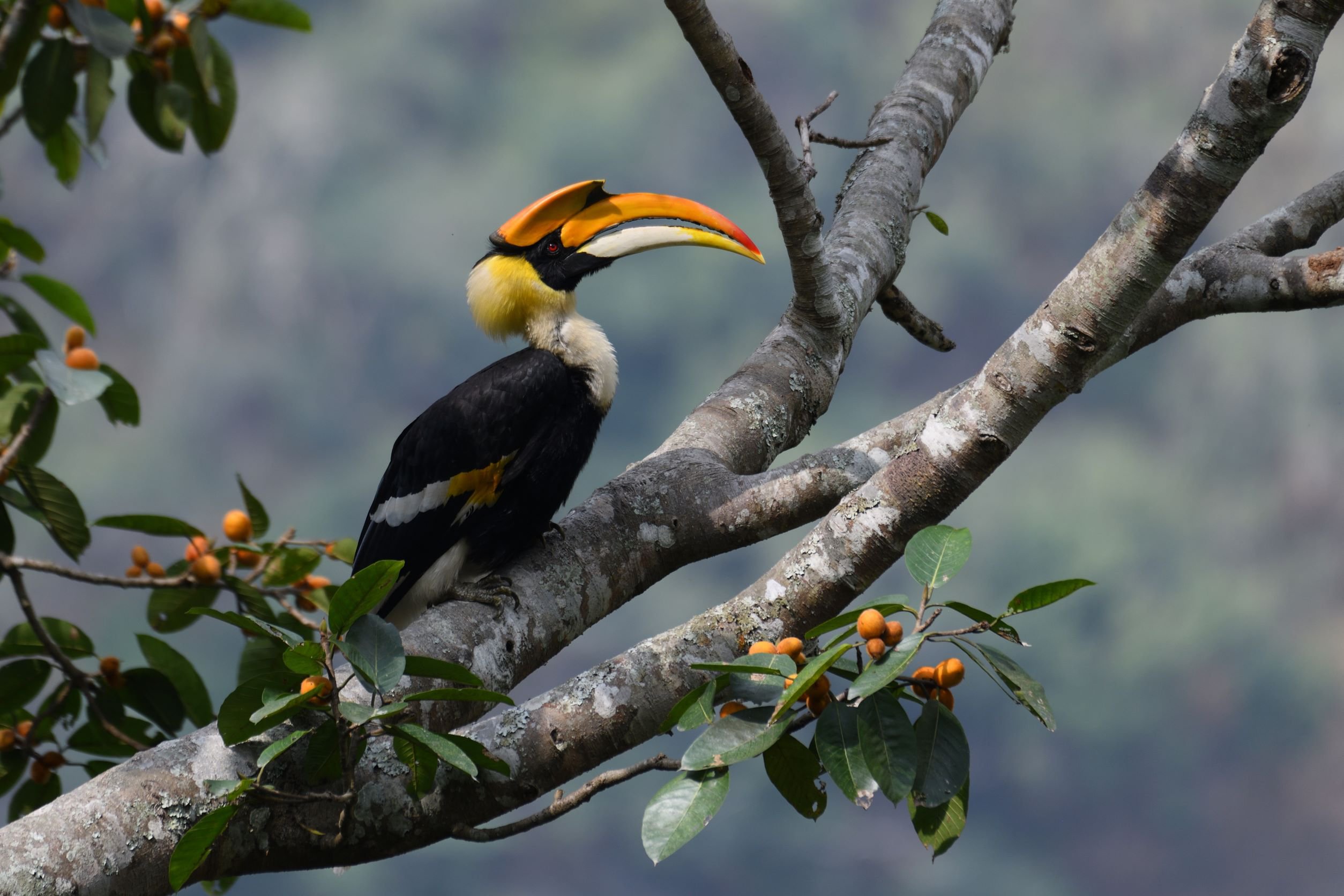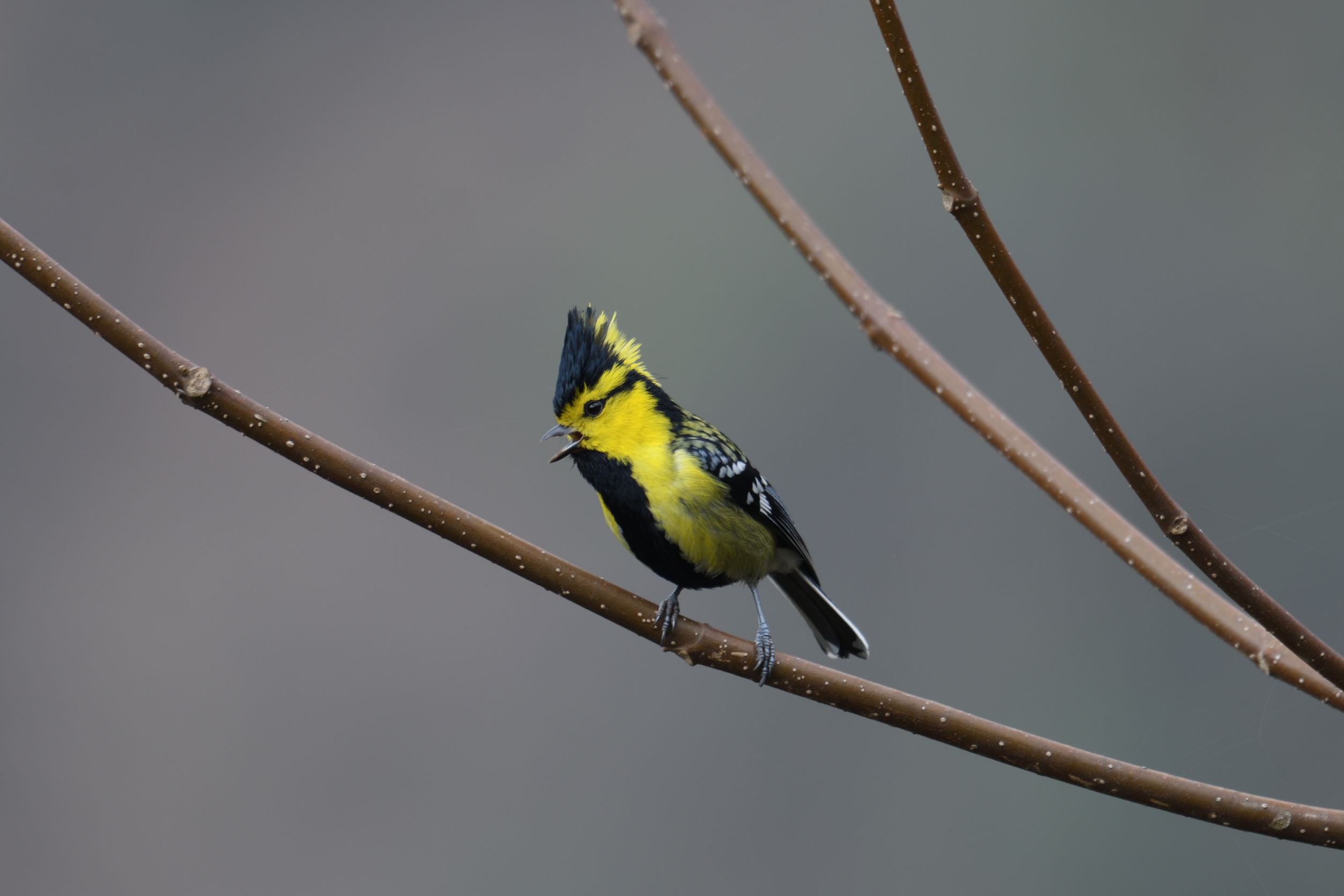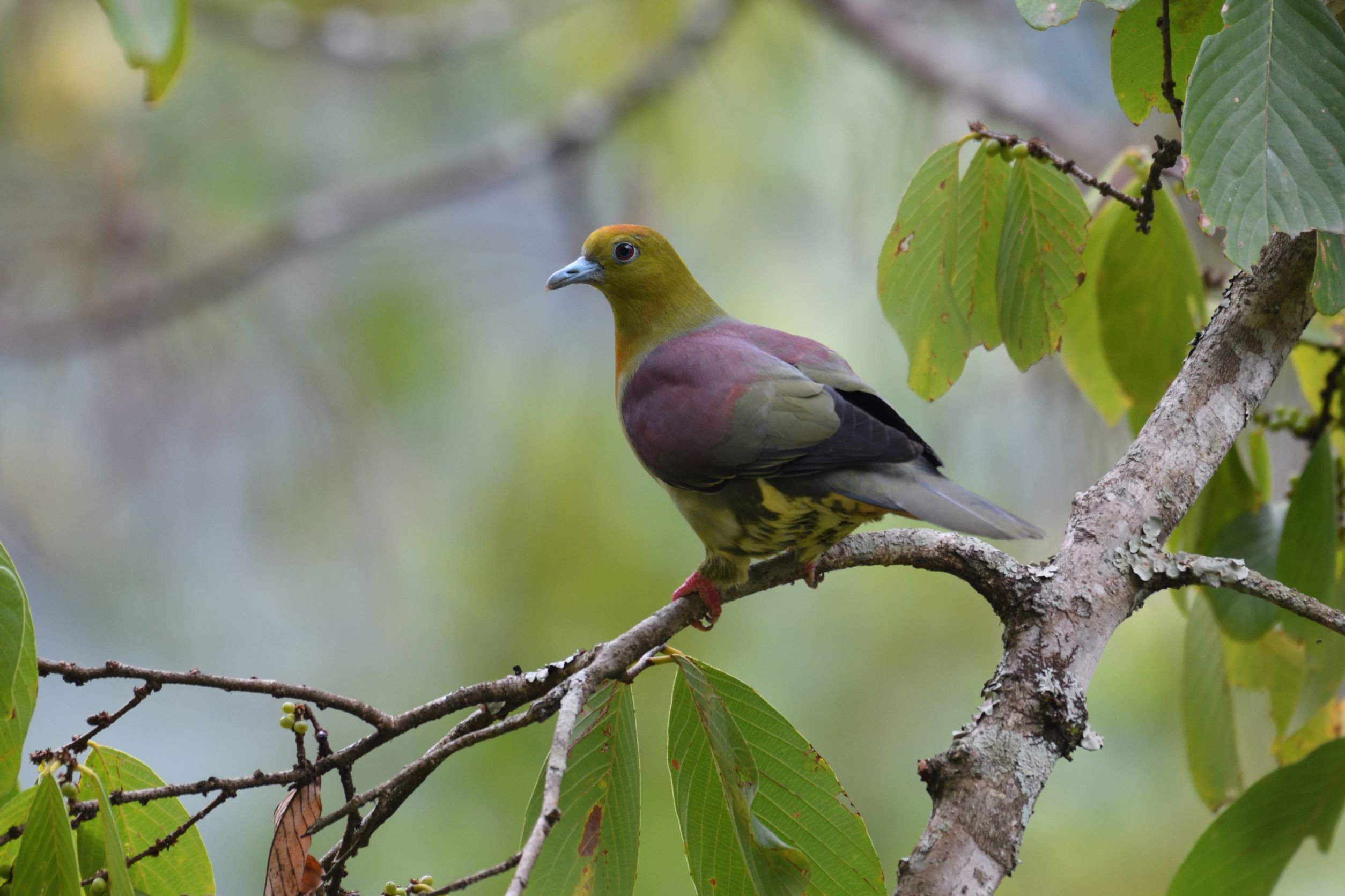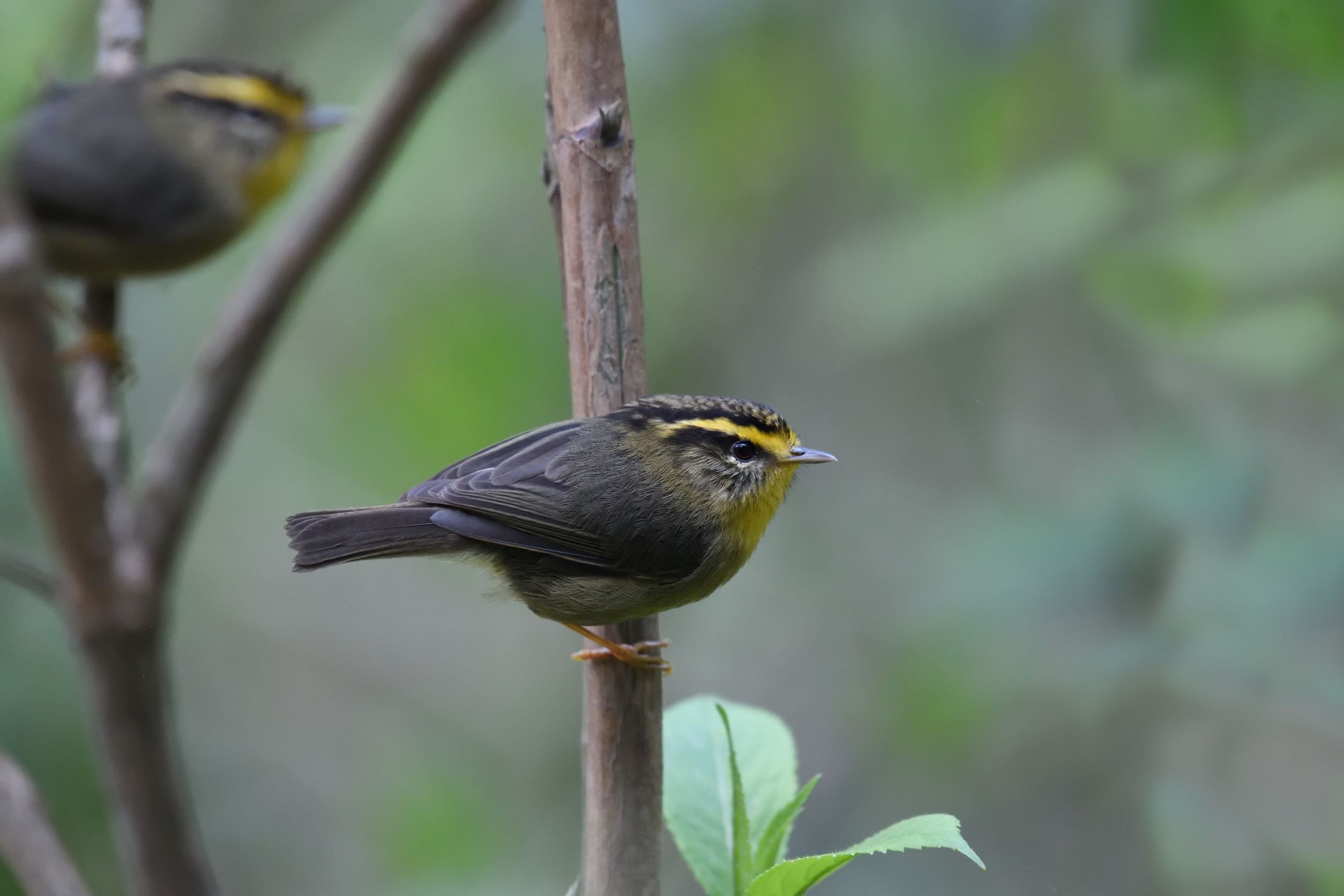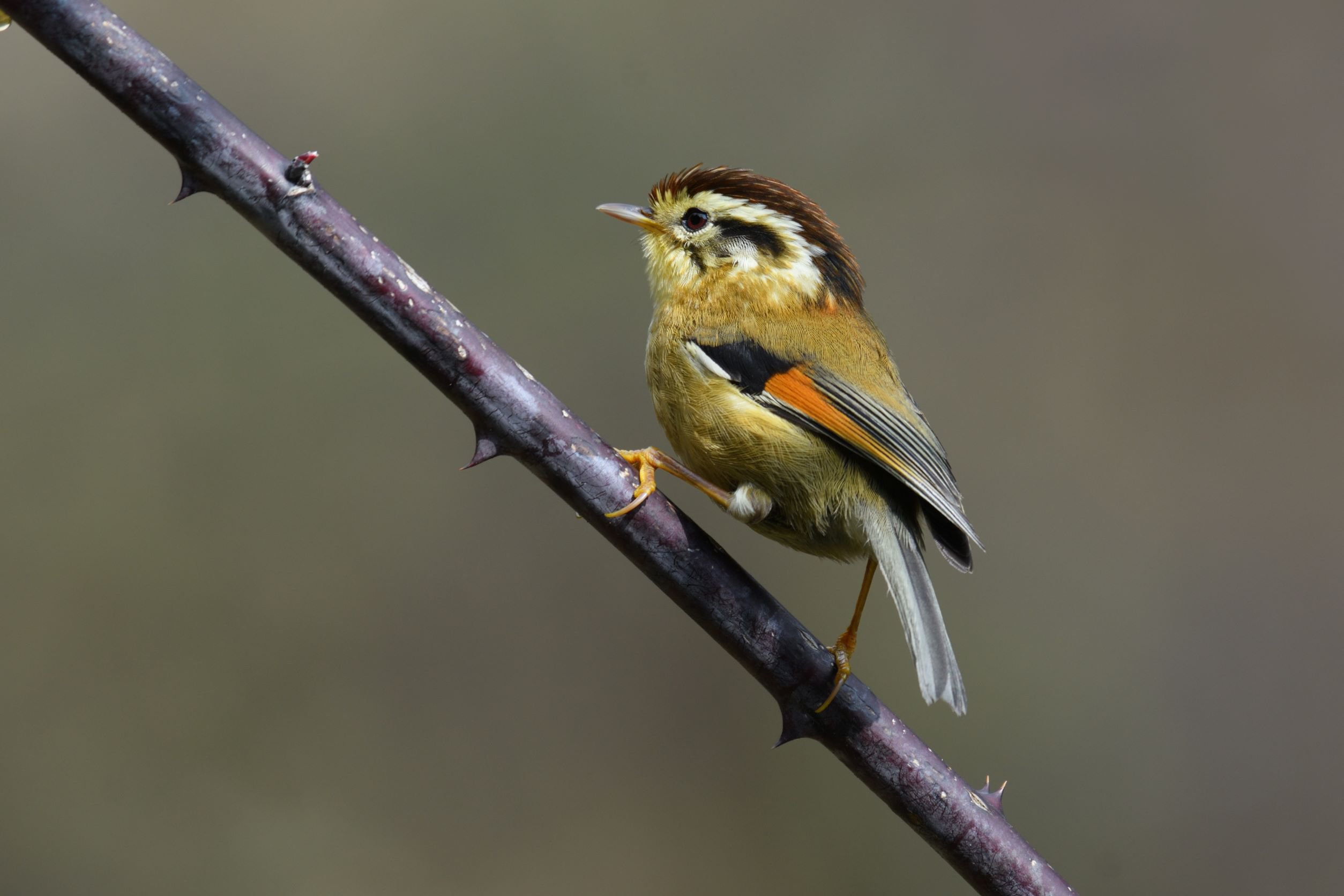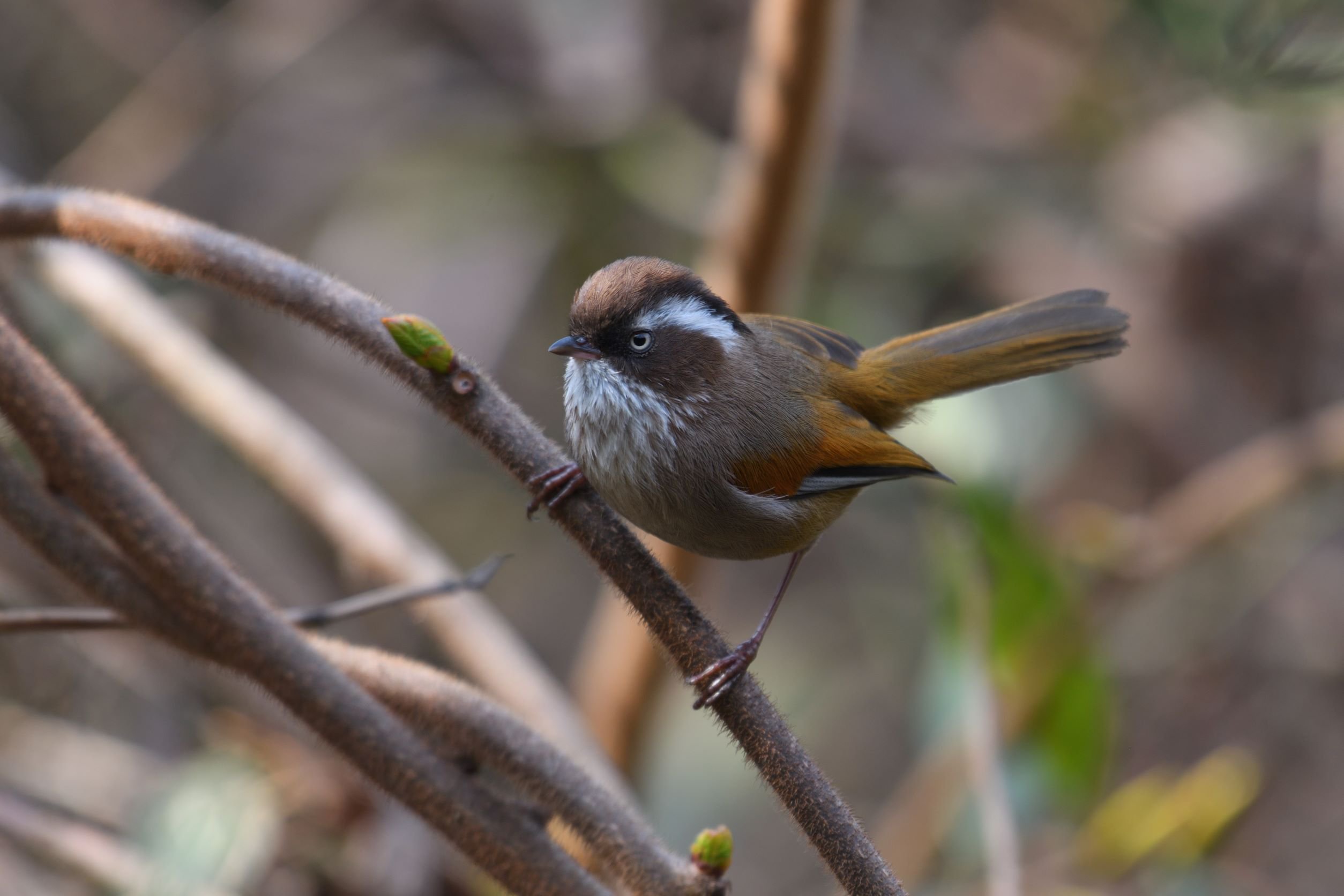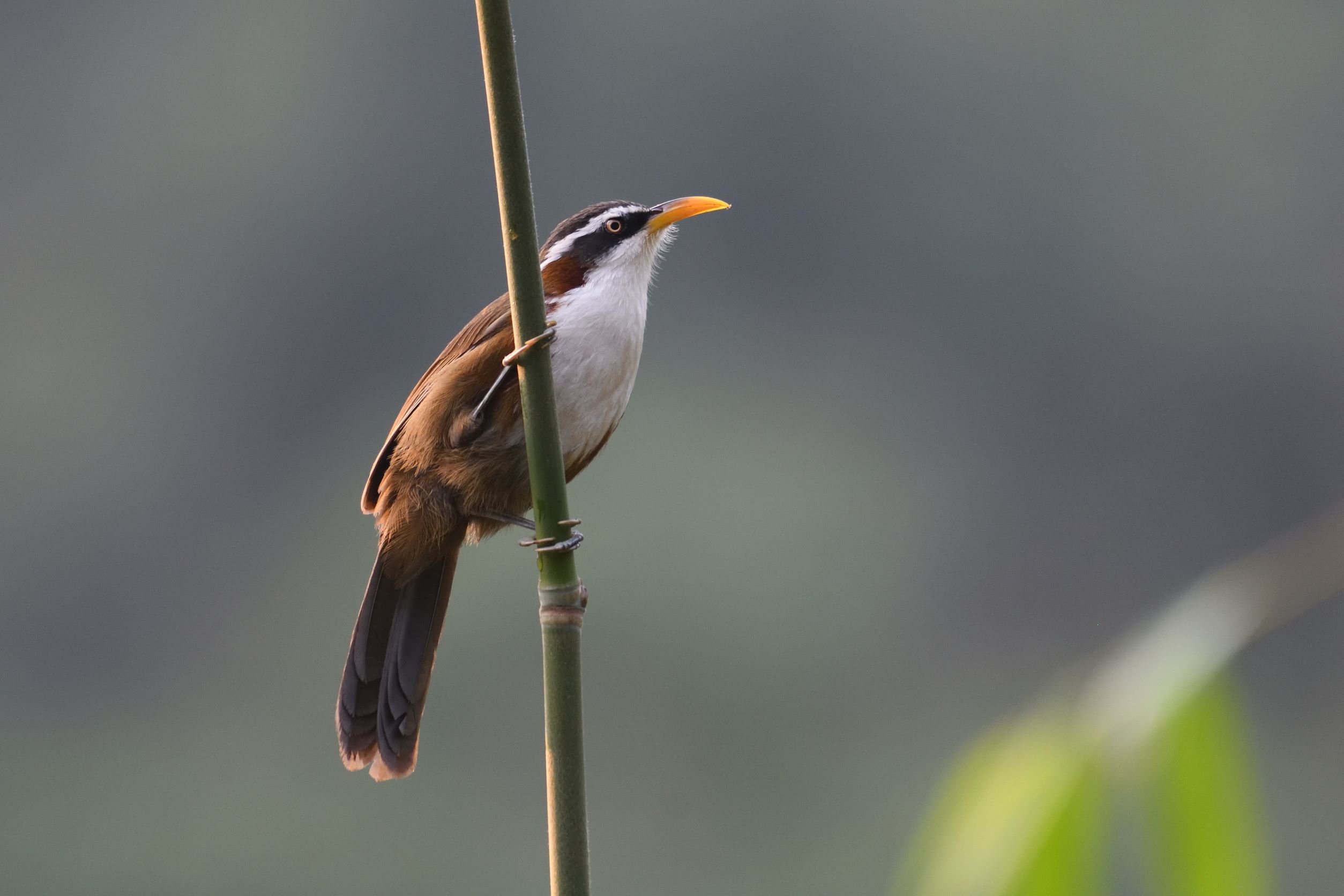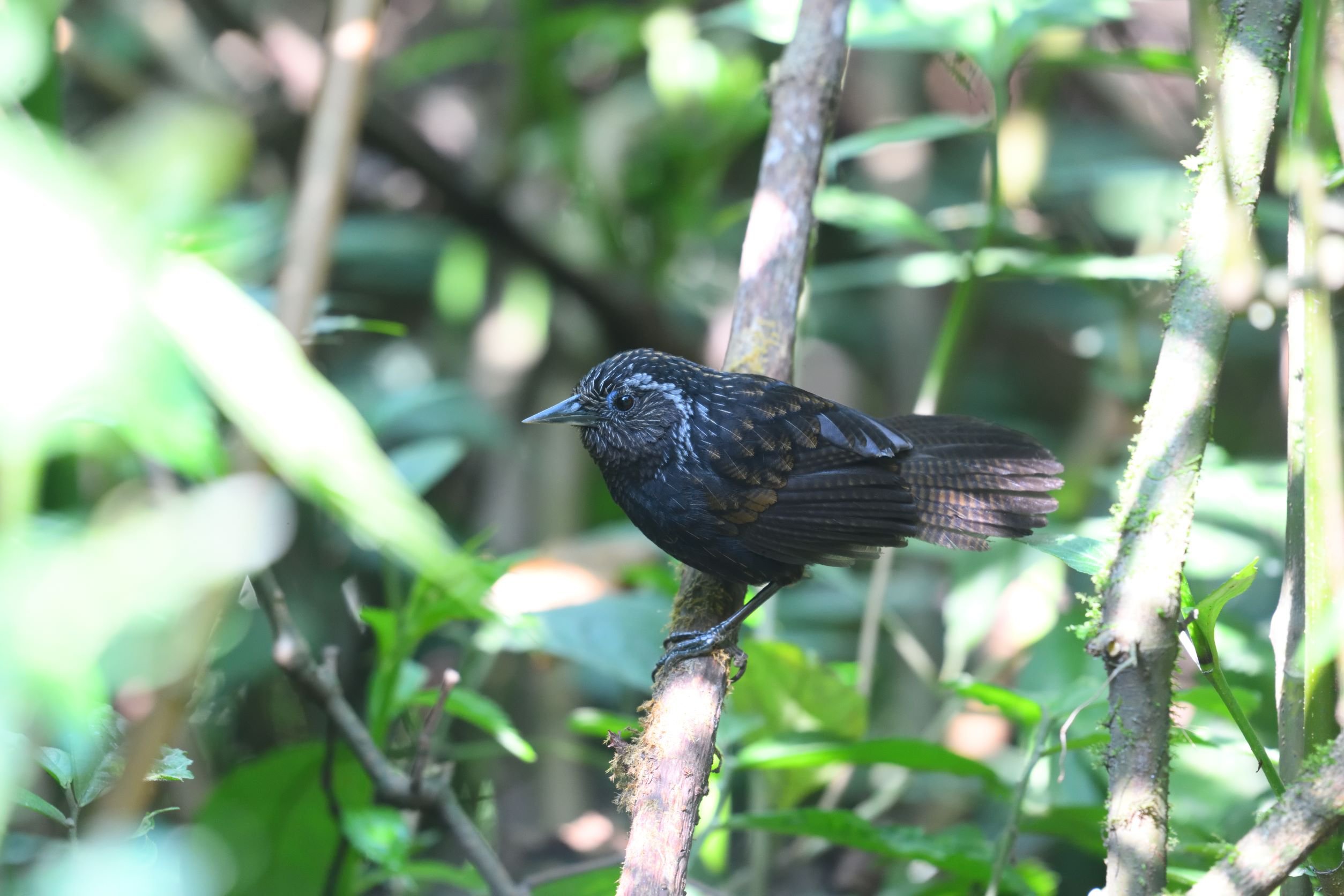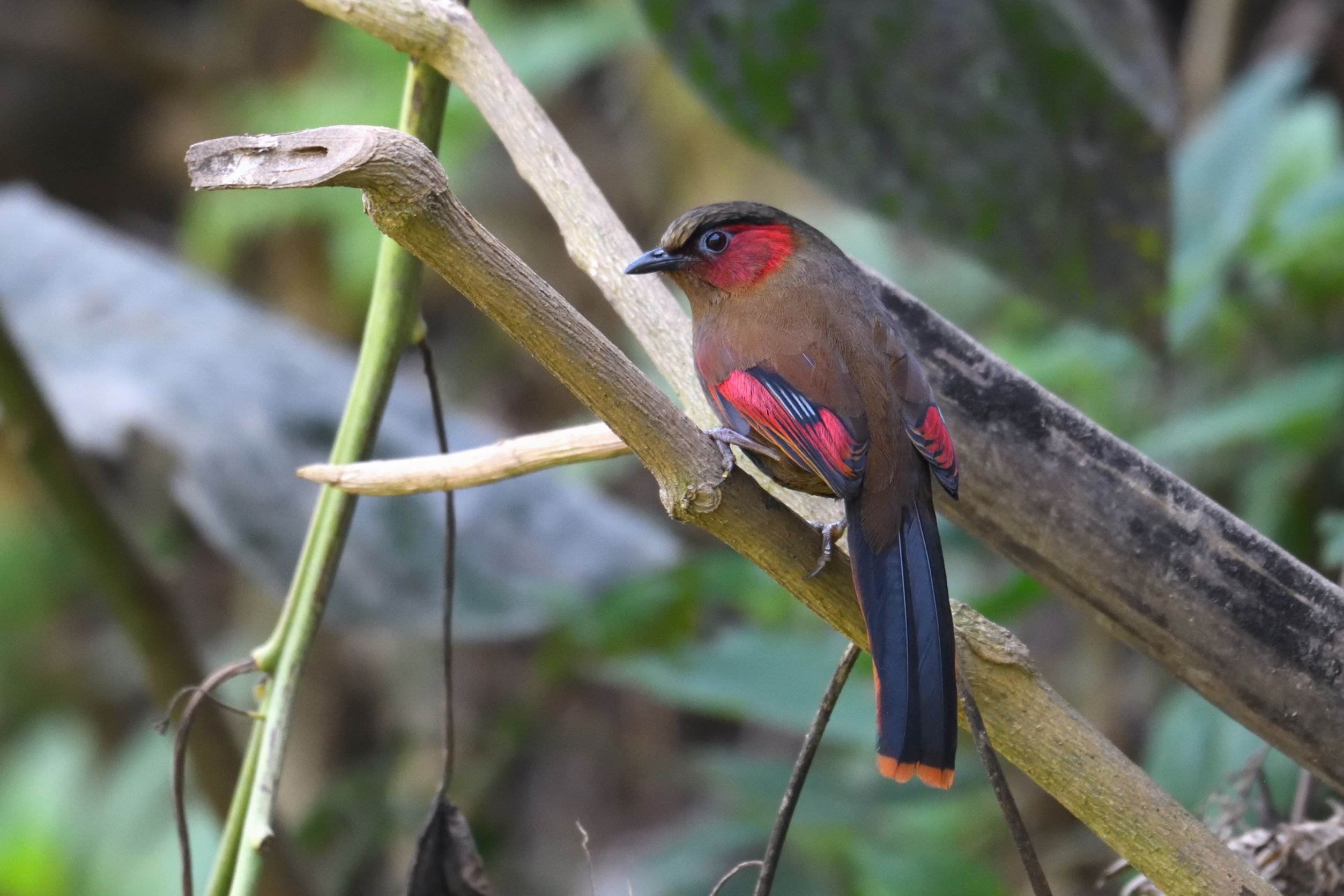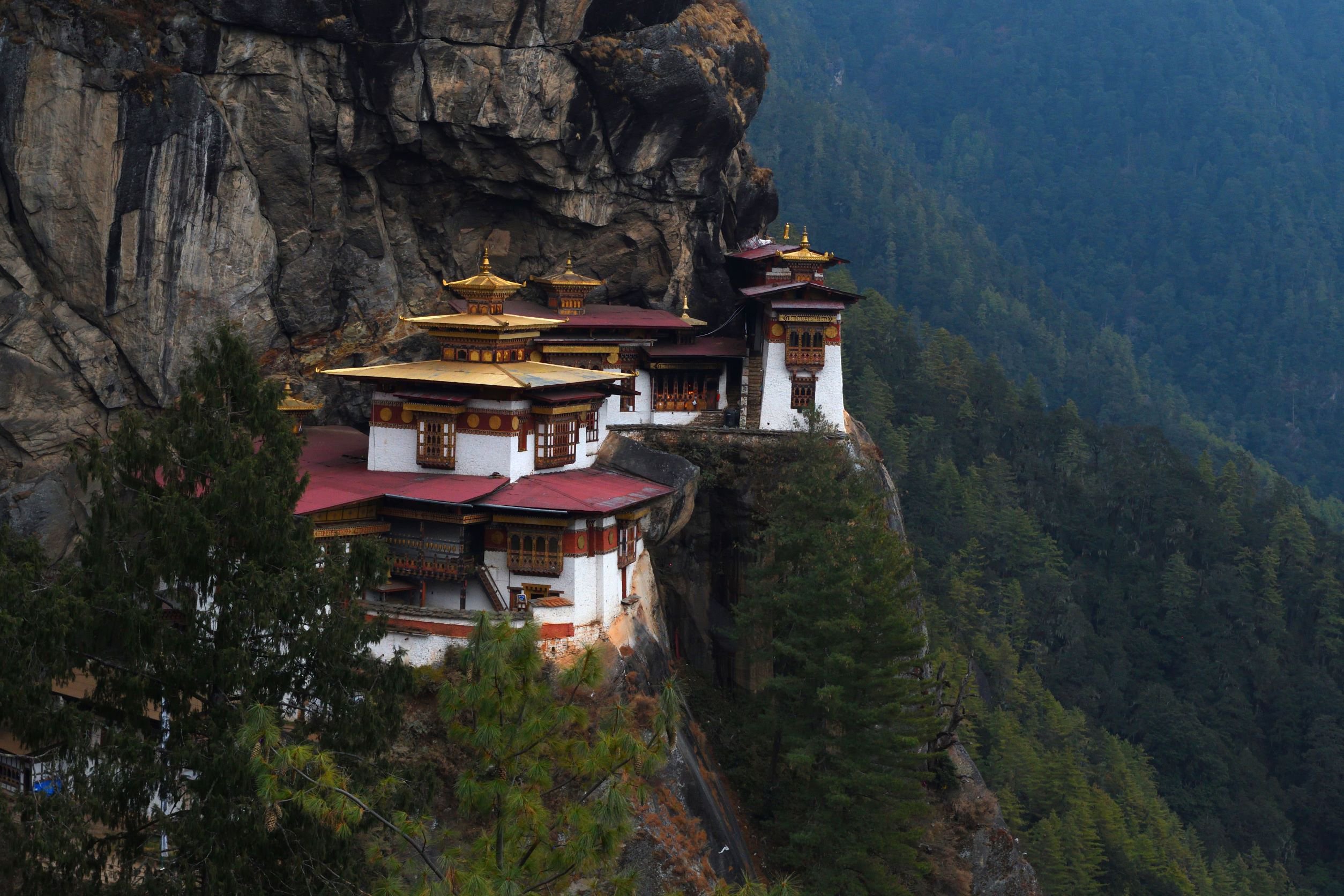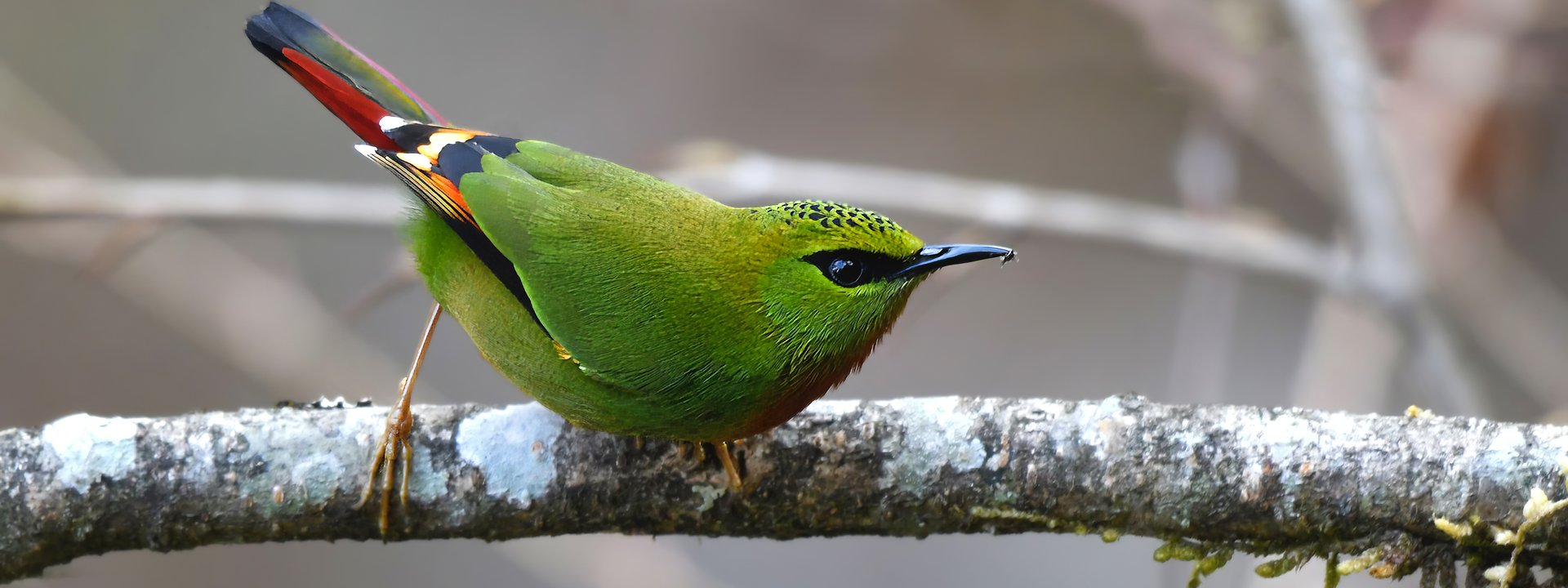Bhutan
Birding in a Himalayan Paradise
A two-week birding, wildlife and cultural experience in the rarely visited Kingdom of Bhutan. ONE MORE BOOKING AND THIS TRIP BECOMES A CONFIRMED DEPARTURE
The Himalayan Kingdom of Bhutan (or Druk yul) is home to the ‘Dragon People’ and is referred to by them as the ‘Land of the Thunder Dragon’. It remains largely unspoilt by the pressures of modern society and is considered to have one of the best-preserved environments in the World and should be on every birder’s list of places to go!
It has majestic, snow-capped peaks to the north and rich forests to the south, incised by fast flowing and crystal-clear rivers. The valleys are adorned with traditional villages and its hilltops with monasteries or fortresses. Within this beautifully preserved landscape the birdlife and wildlife are simply wonderful and our exciting tour goes in search of delights such as Satyr Tragopan, Himalayan Monal, Ward’s Trogon, White-bellied Heron, Fire-tailed Myzornis and Ibisbill. Join us for a never-to-be-forgotten personal journey.
Tour Dates & Prices
Mon 31st March 2025
Sun 13th April 2025
- Available
Tour Cost: 14 Days from £6995 excluding international flights
What's Included?
- Limosa Tour Leader
- Expert English-speaking Bhutanese bird guide
- 11 nights’ accommodation in Bhutan staying at comfortable hotels and overnight hotel in Delhi on outbound journey (depending on flight times)
- All main meals in Bhutan with drinking water provided during the day.
- Surface transportation by minibus
- Internal air ticket from Paro to Bumthang
- All excursions, entry fees, tour-based tips (local guide and driver) and taxes
- Limosa checklist of birds and mammals
Cost Excludes
International flights (UK to Paro), insurance, drinks, airport meals/snacks and other items of a personal nature.
Notes
One more booking and this will be a confirmed departure.
The Land Only Tour Cost is the amount you will pay Limosa plus the Drukair flights from Delhi to Paro which will be booked by our ground agent in Bhutan and we will invoice you separately.
Despite the end of pandemic restrictions, we have taken the decision to continue to price our holidays as excluding international flights.
To keep the process as simple as possible, we are working very closely with a dedicated agent at Travel Counsellors, Sacha Barbato, who is essentially now our “in house” flight consultant.
Sacha is a highly experienced independent ATOL bonded travel agent, and his contact details are as follows: sacha.barbato@travelcounsellors.com and 01603 360099
He will be able to advise you which flights we are recommending for each holiday and will be able to book these for you.
This will also sometimes give you the option to travel from a regional airport if you prefer.
There are only a limited number of routes for flying to Bhutan and we are currently anticipating that the best option will be via Bangkok. Additional accommodation will be required at the beginning and end of the trip. We have not priced this into the cost of the tour but can organise this for those booking on this holiday.
Tour Highlights
- Incredible birdwatching trip to Bhutan
- 11 nights in Bhutan, from Yongkola west to Paro
- Looking for Satyr Tragopan, Himalayan Monal, Blood Pheasant, Himalayan Cutia, Beautiful Nuthatch and Ibisbill plus, Ward’s Trogon, Rufous-necked Hornbill and White-bellied Heron (critically endangered)
- Visiting sites for some of the best birding in all of Asia
- Incredible landscapes unspoilt by the pressures of modern society
- Valleys adorned with traditional villages and traditional Buddhist monasteries.
- Expertly led by Colin Bushell and an expert Bhutanese guide.
Outline Itinerary
Depart UK for Delhi. Overnight in Delhi
Flight from Delhi to Paro and birding along the Paro Chhu (river).
A short flight from Paro to Bumthang (25 mins). Birding to the Selthang La Pass.
Bumthang to Yongkola exploring along one the best birding routes in Bhutan and the Eastern Himalayas.
Two full days to explore Thrumshing La National Park.
Yongkola to Bumthang birding sites include Namling, Sengor, Thrumshing la and Ura valley.
Bumthang to Phobjikha via Tharpaling Monastery for Himalayan Monals.
Phobjikha to Punakha with birding stops at Lawa La Pass, Nobding and Khekekha valley.
Day excursion to Yamey Goenba looking for Ward’s Trogon and Red Panda, afternoon along Puna Tshang Chhu (river valley)
Punakha to Paro birding the areas of Menchuna and Lampelri Botanical Park.
Morning birding at Chele La for some of Bhutan’s top high-altitude birds and return to Paro.
Flight from Paro to Delhi for your onward connection to UK.
Arrive UK
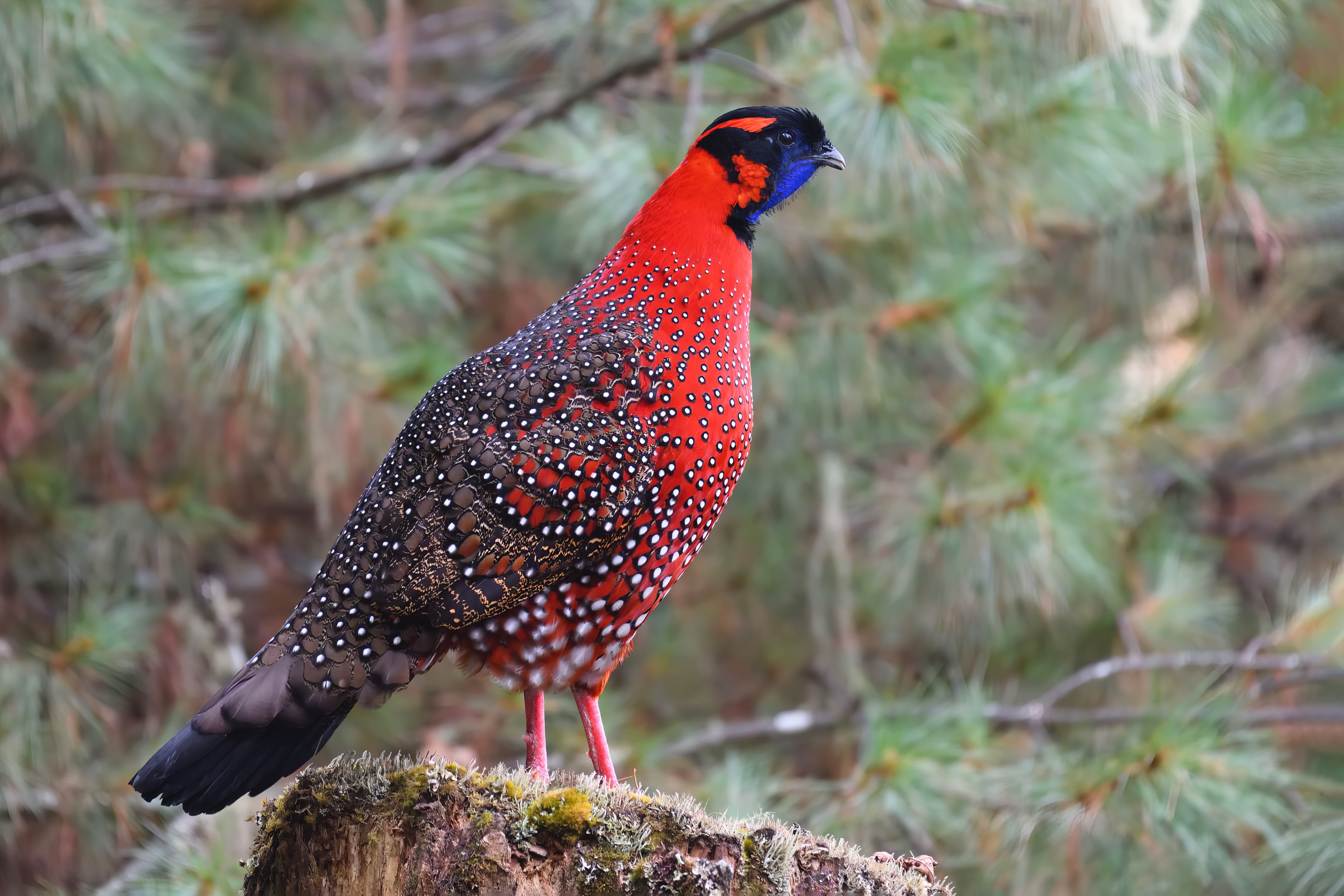
The Himalayan Kingdom of Bhutan (or Druk yul) is home to the ‘Dragon People’ and is referred to by them as the ‘Land of the Thunder Dragon’. It remains largely unspoilt by the pressures of modern society; nowadays it is known as being one of the best-preserved environments in an increasingly developed World and should be on every birder’s list of places to go! It has majestic, snow-capped peaks to the north and rich forests to the south, incised by fast flowing and crystal-clear rivers. The valleys are adorned with traditional villages and its hilltops with monasteries or fortresses.
Within this beautifully preserved landscape the birdlife and wildlife are simply wonderful and our exciting new Limosa tour goes in search of delights such as Himalayan Monal, Ward’s Trogon, White-bellied Heron, Fire-tailed Myzornis and Ibisbill. Join us for a never-to-be-forgotten personal journey.
Paro is our gateway to the mighty Kingdom of Bhutan and after a day birding here, we fly east to Bumthang, from where we slowly drive west back to Paro, exploring rich valleys, mountain passes and mix of habitats at varying altitudes. We have chances for more than 300 bird species including pheasants, laughingthrushes, warblers, fulvettas, yuhinas and sibias, with the fascinating backdrop of the landscape, people and culture of Bhutan.
Our first afternoon at Paro will give us our first chance to find the sought-after and unique Ibisbill along the boulder-strewn Pa Chhu (river), as well as Plumbeous Water Redstart, Russet Sparrow and Rufous-breasted Accentor.
After a short flight east to Bumthang, we head east to Yongkola and spend the rest of our holiday slowly returning to Paro taking in much of the birdlife in the sparsely populated valleys and mountains. We can expect to be surrounded by spectacular scenery, see Bhutanese villages and impressive temples but also enjoy some fantastic birds.
Our itinerary has been organised to give us opportunities to look for many of Bhutan’s special birds and possible highlights could include Chestnut-breasted Partridge and Rufous-necked Hornbill in Thrumsing La National Park or watching monks feed wild Himalayan Monals at Tharpaling Monastery. Another and equally stunning pheasant we will look for is Satyr Tragopan and there will also be opportunities to search for the localised and brightly coloured Ward’s Trogon. We may also have a chance for the critically endangered White-bellied Heron which may now number less than 60 individuals in the world.
Spring brings almost perfect weather to Bhutan, and this is undoubtedly the best time to visit. Clouds can sometimes hang low in the valleys, but this will be more than compensated for by the superb array of birds and wildflowers. The wonderful pinks of the rhododendrons and wild azaleas form flowering carpets, whilst flowering meadows are truly wonderful.
Our 2025 tour has been designed especially for us by highly regarded Bhutanese guide Chubzang Tangbi and will be led by Limosa’s East Asia specialist Colin Bushell. We plan to stay in comfortable hotels throughout our stay, without the need for camping!
In a country with a strong Buddhist belief in the balance of nature and well-being, where the philosophy is Gross National Happiness, we believe that our comprehensive itinerary is a perfect balance of birdlife, wildlife, landscape and culture that will improve your own personal happiness!
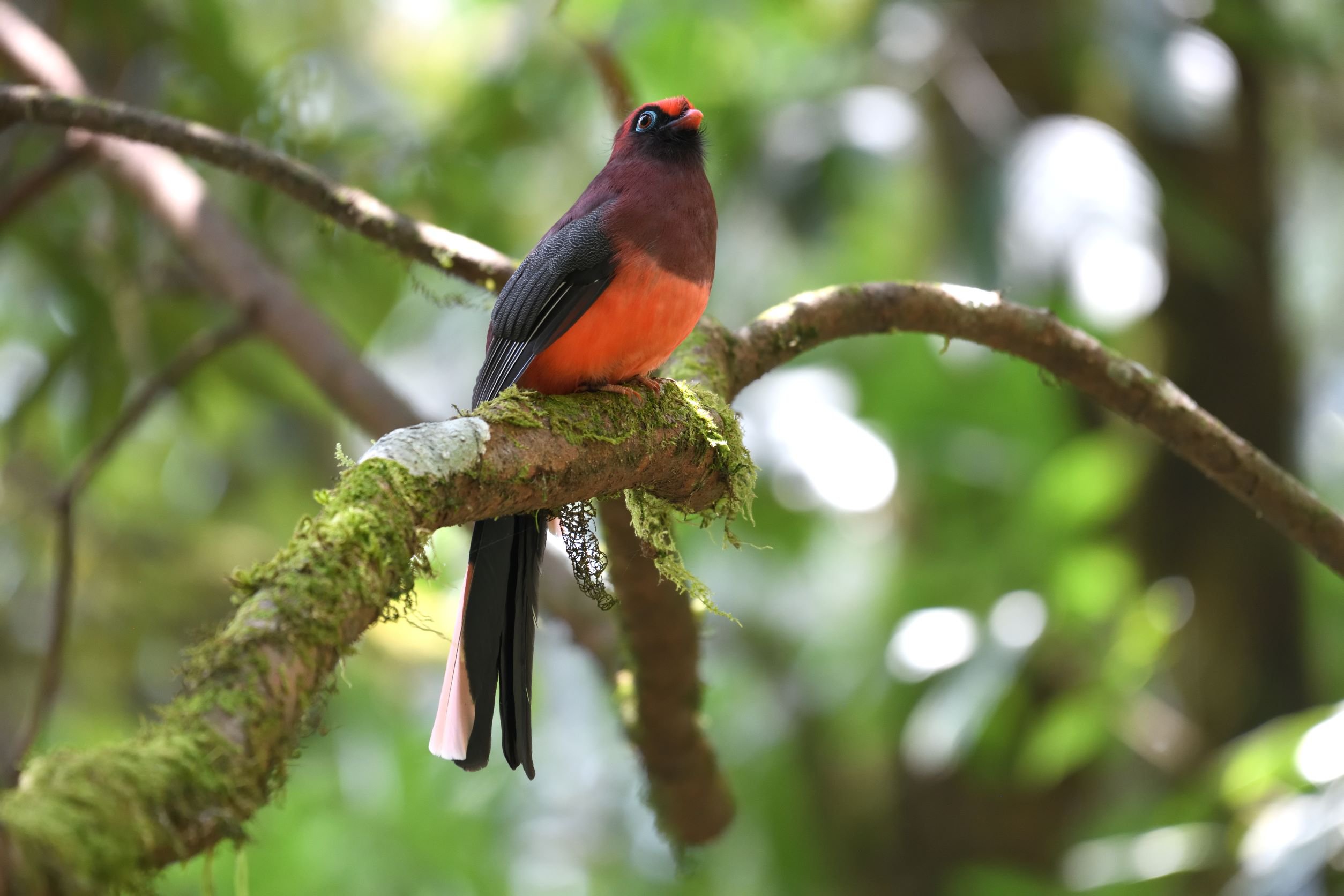
Day 1: Depart UK
Depart UK for Delhi. Overnight in Delhi.
Day 2: Fly from Delhi to Paro and Birdwatching along Paro River
You will take a Drukair/Bhutan Airlines flight from Delhi to Paro, offering magnificent views of the Himalayas, including some of the world's highest peaks.
Depending on flight times, we plan to explore along the Pa Chhu River, where we will have the opportunity to observe various Himalayan riverine species, however, our main target will be the extraordinary but surprisingly camouflaged Ibisbill, which is likely to be searching for food among the glacial stones. Other species we could find in this area include Wallcreeper, Brown Dipper, Himalayan Buzzard, Grey-backed Shrike, Plumbeous Redstart, Russet Sparrow, Rosy Pipit and Rufous-breasted Accentor. Night in Paro.
Day 3: Flight from Paro to Bumthang.Explore along Selthang La Pass
After a short 25-minute flight from Paro to Bumthang, we will begin our exploration of the area. Bumthang holds significant religious importance in Bhutan, with numerous ancient cultural and religious sites dating back to the 7th century and whilst our main focus is birding, we will also have time to explore the main town of Jakar.
As we will drive through Selthang La (3,600m), we will, weather permitting, be treated to breath-taking views of Mt. Gangkar Puensum, standing at an impressive 7,315m as the highest unclimbed peak in the world. The surrounding landscapes will captivate us with their stunning beauty, adorned with prayer flags, traditional Bhutanese villages, and magnificent temples. Truly, this is a magical land!
As we continue along this route, we may encounter species such as the vibrant Spotted Laughingthrush, Rusty-flanked Treecreeper, Long-tailed Minivet, Chestnut-headed Tesia, Dark-rumped Rosefinch, Brown Bullfinch, White-winged Grosbeak, flocks of White-browed Fulvettas, and Grey-crested and Rufous-vented Tits. Night in Bumthang
Day 4: Bumthang to Yongkola
Today, we will embark on an exciting journey from Bumthang to Yongkola, covering approximately 122 km over a 5-hour drive. This route offers some of the finest birding opportunities in Bhutan and the Eastern Himalayas.
As we leave the picturesque Bumthang valley, we will ascend through forests abundant with larch, silver fir, spruce, and towering hemlocks. Our ascent will lead us to Thrumshing La, a mountain pass situated at an elevation of 3,780m. Here, we will begin our exploration of the magnificent forest road, where we will have the chance to spot some of Bhutan's highly sought-after bird species.
We will keep an eye out for the stunning Satyr Tragopan (which we saw exceptionally well in 2023), as well as Blood Pheasant which often feeds by the roadside. Another possibility is the elusive Great Parrotbill, the remarkable Slender-billed Scimitar Babbler (a rare bird in Bhutan) and the uncommon Speckled Wood Pigeon.
Descending from the pass, we will drive towards the nomadic village of Sengor and then continue on to Yongkola. Along the way, we will make stops to observe bird species such as the Yellow-billed Blue Magpie, Rufous-breasted Bush Robin, Rufous-vented Yuhina, Large-billed Leaf Warbler, the photogenic Bar-throated Siva (previously known as Chestnut-tailed Minla), Rufous, Grey-chinned Minivet, Grey-sided Bush Warbler, and Hoary-throated Barwing. Night in Yongkola
Days 5-6: Explore Thrumshing La National Park
During the next two full days, we will immerse ourselves in the captivating beauty of Thrumshing La National Park, which is renowned as one of the premier birding locations in Bhutan. The areas of Yongkola, Namling, Tshamang, and Lingmethang offer an extraordinary birding experience, making them among the finest birding locations anywhere in the world.
We will explore the pristine forests of Thrumshing La National Park, traversing a paved but rarely used road giving us the opportunity to search for some of Bhutan's most coveted bird species.
Our birdwatching targets include the globally vulnerable Chestnut-breasted Partridge, the magnificent Rufous-necked Hornbill (widely distributed in Bhutan but rare elsewhere in the world), the globally endangered Steppe Eagle, Bay and Crimson-breasted Woodpeckers, Long-tailed Broadbill, the rare Blue-naped Pitta, Yellow-throated and Golden-breasted Fulvettas, the peculiar-looking Sikkim Wedge-billed Babbler, Long-billed and Rufous-throated Wren Babblers, Himalayan Cutia (another much sought-after bird), Spotted Elachura (formerly known as Spotted Wren Babbler), Broad-billed and Chestnut-crowned Warblers and Black-headed Shrike-babbler.
We should also find Nepal House Martins with their large nests on overhanging cliffs near Namling waterfall, as well as Black Bulbul, Scaly and Bhutan Laughingthrushes, Orange-bellied Leafbird, Yellow-bellied Fantail, Lesser Shortwing, Slaty-bellied Tesia, Mountain Tailorbird, White-gorgeted and Little Pied Flycatchers.
After exploring the upper region of Yongkola, we will venture into the wonderfully rich, warm broad-leafed forests along Lingmethang road where we will look for Asian Emerald, Chestnut-winged, and Grey-bellied Cuckoos, Grey-headed and Grey-capped Pygmy Woodpeckers, the stunning Red-faced Liocichla, Rufous-chinned Laughingthrush, Maroon Oriole, Lesser Racket-tailed Drongo, White-throated Fantail, Grey Treepie, Grey-bellied Tesia, Striated Prinia, Rufous-capped and Golden Babblers, Grey-headed and Greater Rufous-headed Parrotbills, Mountain and Striated Bulbuls, Black-chinned Yuhina, Rufous-bellied Niltava, Orange-headed Thrush, Blue-capped Rock Thrush, Grey-cheeked and Black-faced Warblers, and Dark-sided, Snowy-browed, and Sapphire Flycatchers.
On one evening, we may take on a short ‘night drive’ hoping to find the Bhutan Giant Flying Squirrel, as well as various owls (both Brown Wood Owl and Mountain Scops Owl are possible albeit both are rather elusive) and Hodgson's Frogmouth (Yongkola being the only known regular site for this species in Bhutan. Two further nights inYongkola
Day 7: Birding from Yongkola to Bumthang, exploring Namling, Sengor, Thrumshing La and Ura Valley
Today, we will travel from Yongkola to Bumthang, covering various birding sites along the way, including Namling, Sengor, Thrumshing La, and the scenic Ura Valley.
Our morning birding session begins in the cool broad-leafed forests of the Namling region where we have the opportunity to look for species including Black-eared Shrike Babbler, Chestnut-bellied Rock Thrush and Black-throated Parrotbill.
After a satisfying breakfast, our birding exploration continues along the picturesque Sengor valley and this higher mid-temperate forest offers the chance for some special birding encounters, with the possibilities including the attractive (and monotypic) Fire-tailed Myzornis and Fire-tailed Sunbird, which is often considered of the most attractive sunbirds in the world. We will also keep an eye out for the elusive Bar-winged Wren Babbler and Tickell's Thrush and have another opportunity to spot the rare Satyr Tragopan.
Continuing our journey, we drive up to the high pass of Thrumshing La at an elevation of 3,780m and along the way will make stops to search for the Fulvous Parrotbill, Black-throated Thrush and Stripe-throated Yuhina.
Descending from the pass, we traverse dense conifer forests, providing further opportunities to look for some more special bird species with the vibrant Himalayan Monal and Blood Pheasant being two of the possibilities. Other bird we could see include Himalayan Bluetail, Whistler's Warbler, White-collared Blackbird, Green-tailed and Gould's Sunbirds, Little Bunting and, if we are very fortunate, Chestnut Thrush and Robin Accentor. Night in Bumthang
Day 8: Bumthang to Phobjikha via Tharpaling Monastery for Himalayan Monals
We have an early start to ensure we reach Tharpaling Monastery to witness the extraordinary sight of monks feeding Himalayan Monals. These stunning pheasants have become accustomed to this practice and it provides an incredible opportunity to observe these magnificent birds.
While at the monastery, we will also keep an eye out for other bird that inhabit the area with Snow Pigeon, Black-faced Laughingthrush, White-bellied Redstart, Alpine Accentor, Himalayan Beautiful Rosefinch amongst the species we could find.
After a satisfying breakfast, we will descend to Gattsa valley and continue our journey to Yotong La at an altitude of 3,450m. Birding in this high-altitude region, we will have the opportunity to encounter several species we may not have seen so far, such as Red-throated Thrush, Ultramarine Flycatcher, Red-headed Bullfinch, Hume's Bush Warbler, Tickell's Leaf Warbler, Rufous-winged Fulvetta, White-winged Grosbeak and Whiskered Yuhina.
Continuing our exploration, we will explore Trongsa and along Pele la road with chances Satyr Tragopan, Fire-tailed Myzornis, Fire-tailed Sunbird, Crimson-browed Finch, Rufous-vented Yuhina, Spotted Nutcracker and Himalayan Vulture. Night in Phobjikha
Day 9: Phobjikha to Punakha with birding stops at Lawa La pass, Nobding, and Khelekha valleys
Our journey from Phobjikha to Punakha is a distance of approximately 125 km and will take us around 4-5 hours but we will make several birding stops as we travel with these likely to include Lawa La pass, Nobding, and Khelekha valleys.
From the pass, we should have breathtaking views of the high Himalayas and will be on the lookout for species such as the magnificent Lammergeier (Bearded Vulture), Oriental Skylark, Plain Mountain Finch, Dark-breasted Rosefinch and many more.
Our next stop is Nobding, where we have another opportunity to find the rare Ward's Trogon. This montane species is endemic to the Eastern Himalayas and if we have not already seen it, we will prioritise looking for this special bird.
Other notable birds in the area include Rufous-bellied Woodpecker, Hodgson's Hawk Cuckoo, the elusive Long-billed Thrush, the beautifully coloured Chestnut-crowned Laughingthrush, dazzling Scarlet Minivets, Yellow-cheeked Tit, Small Niltava (especially the glowing male), Pygmy Blue Flycatcher, Fire-capped Tit and Crimson-browed Finch.
Continuing our journey towards the warmer valley of Punakha, we make a stop along the Puna Tshang Chhu (river) to observe water birds which could include Bar-headed Goose, Ruddy Shelduck, Indian Spot-billed Duck, River and Red-wattled Lapwings, Long-billed Plover, Spotted Dove, Long-tailed Shrike, White-throated Kingfisher, Oriental White-eye, Scaly-breasted Munia, White-browed Wagtail, Oriental Magpie Robin and the localised Slender-billed Oriole. Night in Punakha
Day 10: Morning excursion to Yamey Goenba and afternoon birding along the Puna Tshang Chhu river valley
We start our day by heading to Yamey Goenba, a beautiful destination surrounded by cool broad-leaved forests where we have another chance to encounter the rare Ward's Trogon and Black-headed Shrike Babbler.
Along with these special species, we will also be searching for more regular bird species including Slender-billed and Streak-breasted Scimitar Babblers, Himalayan Cuckoo, Red-billed Leiothrix, Greater Yellownape, Red-vented, Striated, Black, and Mountain Bulbuls, Orange-bellied Leafbird, Large and Small Niltavas, Nepal Fulvetta, Rufous-capped Babbler, Blue-winged Minla, Whiskered Yuhina, Slaty-bellied Tesia, Ashy Drongo, Tibetan Siskin and Spot-winged Grosbeak.
Apart from observing the astonishing variety of birds, we will also keep a lookout for the rare and elusive Red Panda which can sometimes be found in this area.
Around midday and as the bird activity lessens, we will return to Punakha and continue birding along the Puna Tshang Chhu river valley. Some of the species we could encounter include the critically endangered White-bellied Heron, the rare Pallas's Fish-eagle, Pallas's Gull, Small Pratincole and Crested Kingfisher. Second night in Punakha
Day 11: Punakha to Paro birding in the areas of Menchuna and Lampelri Botanical Park
We continue our journey back to Paro covering a distance of approximately 125km and will explore Menchuna and Lampelri Botanical Park.
As we pass through the terraced fields of Lobesa, we will enter the mixed broad-leaved forest of Menchuna where we will take on a short off-road trail looking for Kalij Pheasant, Besra, Short-billed Minivet, Ashy Drongo, Black-throated Tit, Pygmy Wren Babbler (Cupwing), Brown-throated Treecreeper, Slaty Blue Flycatcher and the beautiful Golden Bush Robin.
After a picnic lunch in a picturesque setting, we will proceed to Lampelri Botanical Park for another short walk, where we will search for Hill Partridge, Darjeeling Woodpecker, Ashy-throated Warbler, Streak-breasted Scimitar Babbler, Green Shrike Babbler, Brown Parrotbill, Alpine Thrush (recently split from Plain-backed Thrush), Grey-winged Blackbird, Blue-fronted Redstart, Yellow-browed Tit, Rufous-gorgeted Flycatcher, White-browed Shortwing, Maroon-backed, Dark-breasted Rosefinch, and, if we are very lucky, the rare and elusive Blue-fronted Robin.
Our next stop is Dochu La, a breathtaking sight where vibrant prayer flags and 108 gleaming white chortens welcome us. On clear days, we will be treated to magnificent views of the high Himalayan Mountains before we continue on to Paro for a two night stay. Night in Paro
Day 12: Birding at Chele La (3,988m) for some of Bhutan's top high-altitude birds
We begin our day with an early morning departure to explore the high boreal forests on Chele La which reach an impressive altitude of 3,988m. Along this route, we will keep an eye out for Grey Nightjar, which can sometimes be seen along the roadside at dawn. On reaching the pass, we will be greeted by more breathtaking views of the towering Himalayan peaks, including Jhomolhari (7,219m) and Jichu Drake (6,989m), as well as panoramic vistas of the Paro and Ha valleys.
At Chele La, we should have some final opportunities to observe the colourful Himalayan Monal and Blood Pheasant with other notable possibilities including Long-legged Buzzard, Himalayan Cuckoo, Rufous-fronted Tit, Greenish Warbler, Red-tailed Minla, Hodgson's Treecreeper, Black-throated Thrush, Dusky Thrush, Blanford's Rosefinch, Collared Grosbeak, White-throated Redstart, White-browed Bush Robin, Alpine Accentor and Plain Mountain Finch. Second night in Paro
Day 13: Fly to Delhi for your onward connection.
We will take a morning flight from Paro to Delhi with your onward connection to UK.
Day 14: Arrive UK
We will arrive back in the UK where our tour to Bhutan concludes.
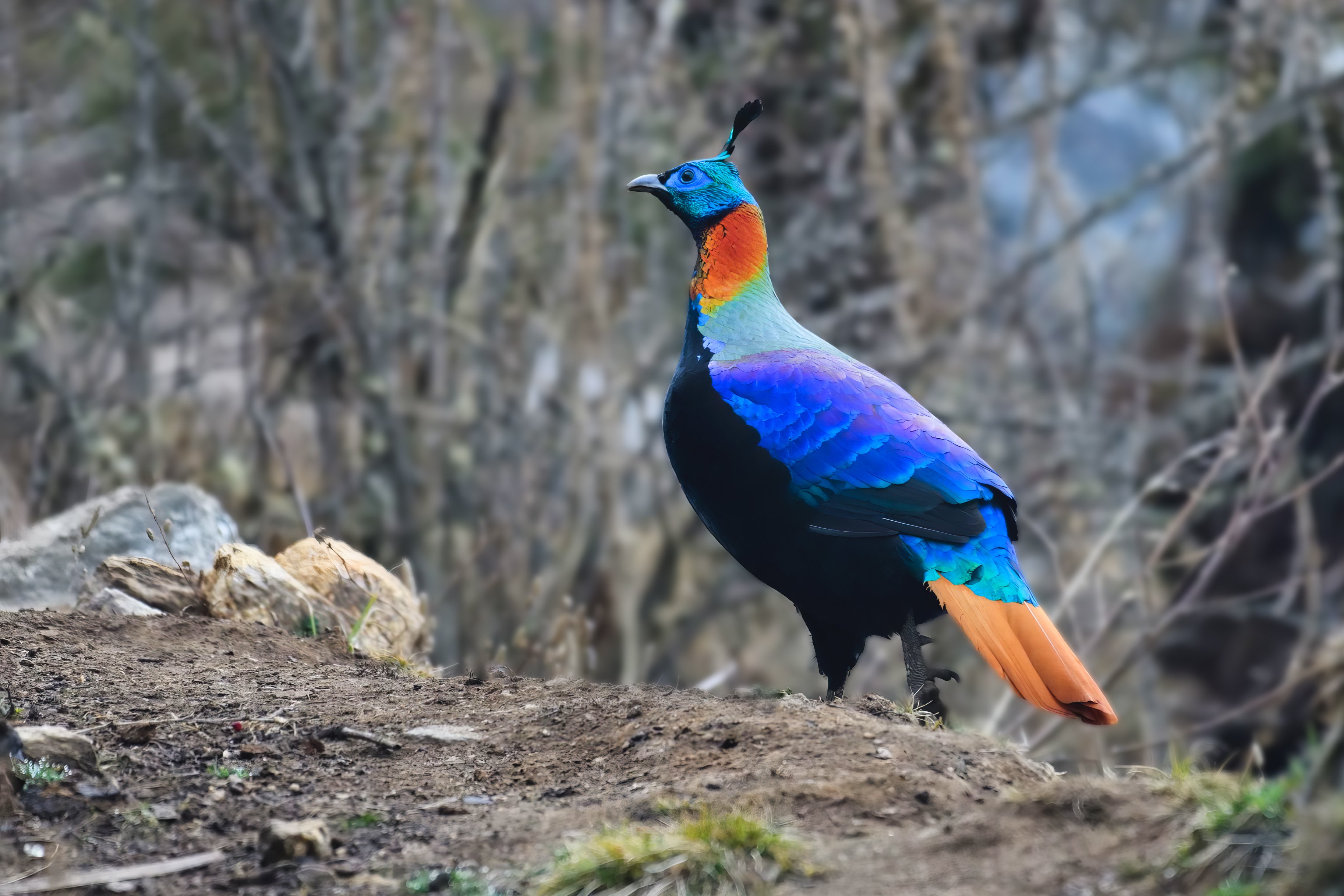
What to expect
A small group birdwatching tour to Bhutan with eleven nights in Bhutan.
We fly east to Bumthang from Paro and then gradually make our way back to Paro, a journey which will involve crossing a number of passes, the highest of which has an elevation approaching 4,000m.
Early starts are the norm for birding tours in tropical regions, where the daylight hours are about 12 hours (with dawn at approximately 5:30am in April). It takes time for the sun to reach the valleys but bird activity is at its peak early morning and late afternoon but at altitude it can sometimes stay busy throughout the day.
Overall, the tour is not strenuous, but you should be prepared for early starts to enjoy the best of the morning’s birding. It will be important to be in the field at dawn on most days so we can hear the birds singing and calling as the day begins. In some instances, this may be our only chance to discover if certain species are present, so we will naturally want to make the most of this opportunity.
On some days we do have longer transits, eg between Bumthang to Yongkola and this will provide an opportunity to relax in the vehicle and take in the amazing landscapes.
Spring brings almost perfect weather to Bhutan, and this is undoubtedly the best time to visit. Clouds can sometimes hang low in the valleys, but this will be compensated for by the superb array of wildflowers. The pinks of the rhododendrons and wild azaleas form flowering carpets, whilst flowering meadows are wonderful.
Temperatures can vary greatly depending on local conditions and altitude. Expect it to be very cold on the high passes early in the morning and hats, gloves and fleeces are the norm. In the valleys, it will be cool spring-like temperatures, rarely reaching 30C and usually in the range of 10-25C.
Some rain is possible but usually not enough to impede birding and snowfall is possible at the high mountains passes.
Birds 250-350 species
Mammals 12-20 species
Accommodation
11 nights’ accommodation in Bhutan. All nights will be in medium to good hotels in comfortable and clean rooms with private facilities. We aim to use the best available in the area. There is no camping on our tour.
Meals
All main meals in Bhutan are included in the tour price with drinking water also provided.
We will have a catering team who will cook and serve some hot breakfasts and lunches ‘picnic style’ and these will be eaten in the field. Dinners are mostly buffets served at the hotels where we stay with continental, Indian and Bhutanese options usually available.
Walking
The walking is mostly easy to moderate. We will be doing short walks at altitudes of up to nearly 4,000m. Throughout our tour, the majority of our birding will be done along quiet roadsides and close to our vehicle. Wherever possible, we walk downhill. Some forest trails may have occasional steeper sections, but these are generally quite short.
Some participants may find it helpful to carry a lightweight collapsible stool.
Photography
This is a birding tour, but photographers will have great opportunities to photograph birds throughout the tour.
Bhutan is a Buddhist country where killing is considered sinful, therefore, birds and mammals often appear to be tamer than in some other parts of the world, allowing you to sometimes take stunning photos.
There will, of course, also be some amazing opportunities for landscape and cultural photography.
Ground Transport
Air-conditioned minibus.
Flights
Despite the end of pandemic restrictions, it is still proving extremely difficult to predict future flight prices and schedules. As a result, we have taken the decision to continue to price our holidays as excluding international flights.
To keep the process as simple as possible, we are working very closely with a dedicated agent at Travel Counsellors, Sacha Barbato, who is essentially now our “in house” flight consultant.
Sacha will be able to advise you which flights we are recommending for each holiday, and he will be able to book these for you.
This will also sometimes give you the option to travel from a regional airport if you prefer.
We anticipate for this holiday that we will probably use a Middle Eastern airline (such as Emirates) which will require a change of plane in each direction, but this will have the major advantage that the flight times work better for this itinerary.

Tour Gallery
View a gallery of images for this tour below, click on an image to view as full size with caption
